ШӘЩ…ШұЫҢЩҶШ§ШӘ ШҜЩҲЫҢШҜЩҶ ШҜШұ ШҙЫҢШЁ
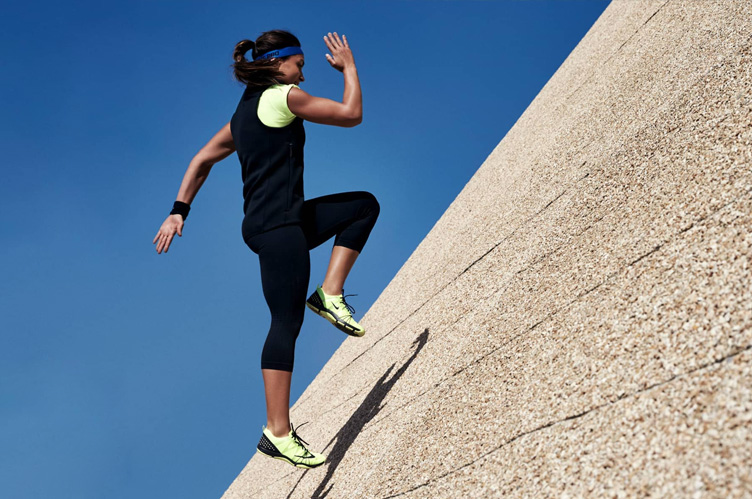 ЩҲЩӮШӘЫҢ ШЁШұШ§ЫҢ Ш§ЩҲЩ„ЫҢЩҶ ШЁШ§Шұ ШҙШұЩҲШ№ ШЁЩҮ ШҜЩҲЫҢШҜЩҶ Щ…ЫҢвҖҢЪ©ЩҶЫҢШҜШҢ Ъ©Ш§Шұ ШіШ®ШӘЫҢ ШҜШұ ЩҫЫҢШҙ ШҜШ§ШұЫҢШҜ. ШЁШіЫҢШ§Шұ ШіЩҶЪҜЫҢЩҶ ЩҶЩҒШі Щ…ЫҢвҖҢЪ©ШҙЫҢШҜ ЩҲ Щ…ШәШІШӘШ§ЩҶ ЩҒШұЫҢШ§ШҜ Щ…ЫҢвҖҢЪ©ШҙШҜ Ъ©ЩҮ ШЁШі Ъ©ЩҶЫҢШҜ.
ЩҲЩӮШӘЫҢ ШЁШұШ§ЫҢ Ш§ЩҲЩ„ЫҢЩҶ ШЁШ§Шұ ШҙШұЩҲШ№ ШЁЩҮ ШҜЩҲЫҢШҜЩҶ Щ…ЫҢвҖҢЪ©ЩҶЫҢШҜШҢ Ъ©Ш§Шұ ШіШ®ШӘЫҢ ШҜШұ ЩҫЫҢШҙ ШҜШ§ШұЫҢШҜ. ШЁШіЫҢШ§Шұ ШіЩҶЪҜЫҢЩҶ ЩҶЩҒШі Щ…ЫҢвҖҢЪ©ШҙЫҢШҜ ЩҲ Щ…ШәШІШӘШ§ЩҶ ЩҒШұЫҢШ§ШҜ Щ…ЫҢвҖҢЪ©ШҙШҜ Ъ©ЩҮ ШЁШі Ъ©ЩҶЫҢШҜ.
ЩҲЩ„ЫҢ Ш§ЪҜШұ ШЁЩҮ ШўЩҶ ЩҫШ§ЫҢШЁЩҶШҜ ШЁШ§ШҙЫҢШҜШҢ Ш·ЩҲЩ„ЫҢ ЩҶШ®ЩҲШ§ЩҮШҜ Ъ©ШҙЫҢШҜ Ъ©ЩҮ ШЁШӘЩҲШ§ЩҶЫҢШҜ ЩҮЩҶЪҜШ§Щ… ШҜЩҲЫҢШҜЩҶ ШЁШ§ ЩҮЩ…ШұШ§ЩҮШ§ЩҶ Ш®ЩҲШҜ ЪҜЩҫ ЩҮЩ… ШЁШІЩҶЫҢШҜ.
ШҜШұ Ш§ЫҢЩҶ ЩҶЩӮШ·ЩҮШҢ Щ…ШұШЁЫҢШ§ЩҶ Щ…ЫҢвҖҢШҜШ§ЩҶЩҶШҜ Ъ©ЩҮ ШҙЩ…Ш§ ШЁШ§ЫҢШҜ ЫҢЪ© ЪҶШ§Щ„Шҙ Ш¬ШҜЫҢШҜ ШЁШұШ§ЫҢ Ш®ЩҲШҜШӘШ§ЩҶ Ш§ЫҢШ¬Ш§ШҜ Ъ©ЩҶЫҢШҜШҢ ШҜШұ ШәЫҢШұ Ш§ЫҢЩҶ ШөЩҲШұШӘ ЩҫЫҢШҙШұЩҒШӘ ШЁШҜЩҶЫҢ ШҙЩ…Ш§ Ъ©ЩҶШҜ Ш®ЩҲШ§ЩҮШҜ ШҙШҜ. Ш§ЫҢЩҶШ¬Ш§ШіШӘ Ъ©ЩҮ ШӘЩ…ШұЫҢЩҶ ШҜШұ ШҙЫҢШЁ Щ…Ш·ШұШӯ Щ…ЫҢвҖҢШҙЩҲШҜ. Ш§ЫҢЩҶ ШЁЩҮШӘШұЫҢЩҶ ЪҶШ§Щ„ШҙЫҢШіШӘ Ъ©ЩҮ ШЁШ№ШҜ Ш§ШІ Ш§ЫҢШ¬Ш§ШҜ ШЁЫҢШі ШіЩҺШЁЪ© ШҜЩҲЫҢШҜЩҶ Ш®ЩҲШҜ Щ…ЫҢвҖҢШӘЩҲШ§ЩҶЫҢШҜ ШҜШ§ШҙШӘЩҮ ШЁШ§ШҙЫҢШҜ.
ШЁЩҮ ЩҮЩ…ЫҢЩҶ ШҜЩ„ЫҢЩ„ Ш§ШіШӘ Ъ©ЩҮ ШҙЩ…Ш§ ЫҢЪ© ШЁШұЩҶШ§Щ…ЩҮ ШҜЩҲЫҢШҜЩҶ ШҜШұ ШҙЫҢШЁ ШұШ§ ШҜШұ ШЁШ®ШҙЫҢ Ш§ШІ ШӘЩҲШ§Щ„ЫҢ ШЁШұЩҶШ§Щ…ЩҮвҖҢЩҮШ§ЫҢ Щ…ЩҶ ШЁШұШ§ЫҢ Ш§ЫҢШ¬Ш§ШҜ ЫҢЪ© ЪҶШұШ®ЩҮ ШўЩ…ЩҲШІШҙЫҢ Ъ©Ш§Щ…Щ„ Щ…ШҙШ§ЩҮШҜЩҮ Щ…ЫҢвҖҢЪ©ЩҶЫҢШҜ.
ЩҒЩҲШ§ЫҢШҜ ШҜЩҲЫҢШҜЩҶ ШҜШұ ШҙЫҢШЁ:
ШЁШ§ ШӘЩ…ШұЫҢЩҶ Ъ©ШұШҜЩҶ ШҜШұ ШӘЩҫЩҮ ШҙЩ…Ш§ Щ…ЫҢвҖҢШӘЩҲШ§ЩҶЫҢШҜ:
- VO2max Ш®ЩҲШҜ ШұШ§ ШӘЩӮЩҲЫҢШӘ Ъ©ЩҶЫҢШҜ
- ШЁЩҮШӘШұЩҮ ШЁШ§ ШӘШ¬Щ…Ш№ Ш§ШіЫҢШҜ Щ„Ш§Ъ©ШӘЫҢЪ© Щ…ЩӮШ§ШЁЩ„ЩҮ Ъ©ЩҶЫҢШҜ
- Ш№Щ…Щ„Ъ©ШұШҜ ЩҫШ§ЩҮШ§ ШұШ§ ШЁЩҮШЁЩҲШҜ ШЁШ®ШҙЫҢШҜ
- ШӘЩ…ШұЫҢЩҶШ§ШӘ Ш§ЩҒЩҲШұШӘ ШЁЫҢШі (ШіШ®ШӘЫҢ Щ…ШӯЩҲШұ) ШұШ§ ШЁЫҢШ§Щ…ЩҲШІЫҢШҜ ШІЫҢШұШ§ ШҜШұ ШӘЩ…ШұЫҢЩҶШ§ШӘ ШҙЫҢШЁ Ш§ЩҒЩҲШұШӘВ Щ…ЩҮЩ…вҖҢШӘШұ Ш§ШІ ШіШұШ№ШӘ ЫҢШ§ Ш¶ШұШЁШ§ЩҶ ЩӮЩ„ШЁ Ш§ШіШӘ
- ШіШұШіШ®ШӘЫҢ Ш°ЩҮЩҶЫҢ ШЁЫҢШҙШӘШұЫҢ Ш§ЫҢШ¬Ш§ШҜ Ъ©ЩҶЫҢШҜ
- ШЁЫҢвҖҢШӯЩҲШөЩ„ЪҜЫҢ ЩҶШ§ШҙЫҢ Ш§ШІ ЫҢЪ©ЩҶЩҲШ§Ш®ШӘЫҢ ШҜЩҲЫҢШҜЩҶ ШұШ§ Ш§ШІ ШЁЫҢЩҶ ШЁШЁШұЫҢШҜ
ЩҲ Ш№ШІЫҢШІШ§ЩҶ Щ…ЩҶ Ш§ЫҢЩҶ ШұЩҗЩҶШ¬ ЪҜШіШӘШұШҜЩҮвҖҢШ§ЫҢ Ш§ШІ ЩҫЫҢШҙШұЩҒШӘ ШЁШұШ§ЫҢ ЫҢЪ© ШҜЩҲЩҶШҜЩҮ Ш§ШіШӘ. ШЁЩҮ ШІШӯЩ…ШӘШҙ Щ…ЫҢвҖҢШ§ШұШІШҜ.
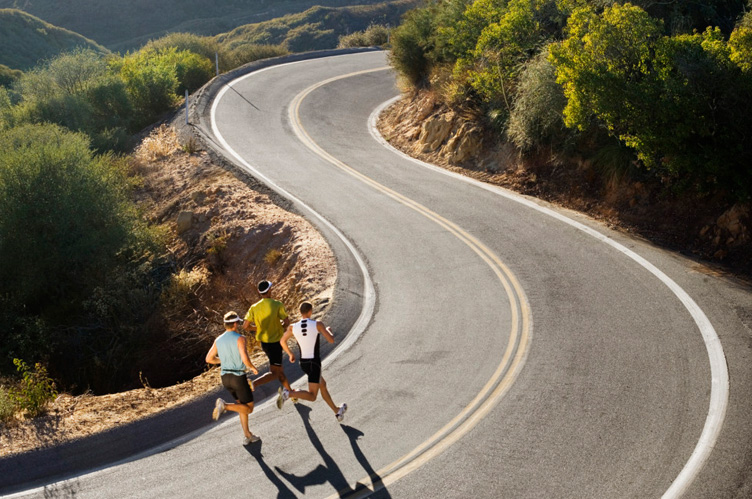
ШҜЩҲЫҢШҜЩҶ ШҜШұ ШҙЫҢШЁ ШЁШіШӘЩҮ ШЁЩҮ ЩҶШӯЩҲЩҮвҖҢЫҢ ШӘЩ…ШұЫҢЩҶ Ъ©ШұШҜЩҶ ЩҮШұ ШҜЩҲЩҶШҜЩҮ ЩҲ Щ…ШұШЁЫҢ Щ…ЫҢвҖҢвҖҢШӘЩҲШ§ЩҶШҜ Щ…ШӘЩҒШ§ЩҲШӘ ШЁШ§ШҙШҜ. Ш§Ъ©Ш«Шұ Щ…ШұШЁЫҢШ§ЩҶ ЩҮЩ… Щ…Ш«Щ„ Щ…ЩҶ Ш§ШІ ШӘЩ…ШұЫҢЩҶШ§ШӘ ШҙЫҢШЁ ШЁЩҮ ЪҶЩҮШ§Шұ ШұЩҲШҙ Ъ©Щ„ЫҢШҜЫҢ Ш§ШіШӘЩҒШ§ШҜЩҮ Щ…ЫҢвҖҢЪ©ЩҶЩҶШҜ:
- Щ…ЩӮШҜЩ…ЩҮвҖҢШ§ЫҢ ШЁШұ ШҜЩҲЫҢШҜЩҶ ШіШұЫҢШ№ШӘШұ ШЁШұШ§ЫҢ ШҜЩҲЩҶШҜЪҜШ§ЩҶ ШӘШ§ШІЩҮ Ъ©Ш§Шұ
- ШЁЩҮ Ш№ЩҶЩҲШ§ЩҶ ЫҢЪ© Щ…ШұШӯЩ„ЩҮ ШӘЩ…ШұЫҢЩҶЫҢ ЩӮШЁЩ„ Ш§ШІ ШҙШұЩҲШ№ Ъ©Ш§Шұ ШіШұШ№ШӘЫҢ
- ШЁЩҮ Ш№ЩҶЩҲШ§ЩҶ ЫҢЪ© ШӘЩ…ШұЫҢЩҶ ШӘШ®ШөШөЫҢ ШҜШұ ЫҢЪ© ШЁШұЩҶШ§Щ…ЩҮ ШӘЩ…ШұЫҢЩҶЫҢ ШЁШұШ§ЫҢ ШўЩ…Ш§ШҜЩҮ ШҙШҜЩҶ ШЁШұШ§ЫҢ ЫҢЪ© Щ…ШіЫҢШұ Щ…ШіШ§ШЁЩӮЩҮ ЩҫШұ ШҙЫҢШЁ
- ШЁЩҮ Ш№ЩҶЩҲШ§ЩҶ ШұШ§ЩҮЫҢ ШЁШұШ§ЫҢ ШӘЩӮЩҲЫҢШӘ ШӘЩҶШ§ШіШЁ Ш§ЩҶШҜШ§Щ… ШЁШұ Щ…ШЁЩҶШ§ЫҢ ШӘЩ…ШұЫҢЩҶШ§ШӘ Ш§ЩҒЩҲШұШӘ ШЁЫҢШі (ШӘЩ„Ш§Шҙ Щ…ШӯЩҲШұ)
ШЁЩҮШӘШұЫҢЩҶ Ш§ЩҶЩҲШ§Ш№ ШӘЩ…ШұЫҢЩҶШ§ШӘ ШҜШұ ШҙЫҢШЁ
ШіШӘвҖҢЩҮШ§ЫҢ ШҙЫҢШЁвҖҢЩҮШ§ЫҢ Ш·ЩҲЩ„Ш§ЩҶЫҢ (Щ„Ш§ЩҶЪҜ ЩҮЫҢЩ„)
ШҙЫҢШЁвҖҢЩҮШ§ЫҢ Ш·ЩҲЩ„Ш§ЩҶЫҢ ШҜШұ ЫҢЪ© ШҙЫҢШЁ ШӘШҜШұЫҢШ¬ЫҢ Ш§ЩҶШ¬Ш§Щ… Щ…ЫҢвҖҢШҙЩҲШҜ ЩҲ ШӯШҜЩҲШҜ ШҜЩҲ ШӘШ§ ШіЩҮ ШҜЩӮЫҢЩӮЩҮ Ш·ЩҲЩ„ Щ…ЫҢвҖҢЪ©ШҙШҜ.
ШҙЩ…Ш§ ШЁШ§ Ъ©ЩҲШҙШҙЫҢ ЩҶШіШЁШӘШ§ ШЁШ§Щ„Ш§ Щ…ЫҢвҖҢШҜЩҲЫҢШҜ (ШЁШ§ЫҢШҜ ШӯШі ШҜЩҲЫҢШҜЩҶ 10K ШұШ§ ШҜШ§ШҙШӘЩҮ ШЁШ§ШҙЫҢШҜ). ШҜШұ ШЁШ§Щ„Ш§ШҢ ШҜЩҲШұ Щ…ЫҢвҖҢШІЩҶЫҢШҜ ЩҲ ЩӮШЁЩ„ Ш§ШІ ШҙШұЩҲШ№ ШҜЩҲШЁШ§ШұЩҮ ШЁЩҮ ШўШұШ§Щ…ЫҢ ШЁЩҮ ЩҫШ§ЫҢЫҢЩҶ ШӘЩҫЩҮ Щ…ЫҢвҖҢШҜЩҲЫҢШҜ.
Ш§Ъ©Ш«Шұ ШҜЩҲЩҶШҜЪҜШ§ЩҶ Щ…ШӘЩҲШ¬ЩҮ Щ…ЫҢвҖҢШҙЩҲЩҶШҜ Ъ©ЩҮ ЪҶЩҮШ§Шұ ШӘШ§ ЩҮШҙШӘ ШіШӘ ШЁШұШ§ЫҢ ЫҢЪ© ШӘЩ…ШұЫҢЩҶ Ш·ЩҲЩ„Ш§ЩҶЫҢ ШҜШұ ШҙЫҢШЁ Щ…Ш·Щ„ЩҲШЁ Ш§ШіШӘ.
ЩҮШұ Ш§ШІ ЪҜШ§ЩҮЫҢ ШҜШұ ШҙЫҢШЁвҖҢЩҮШ§ЫҢ Щ…ЩҶЩҒЫҢ ШіШұШ№ШӘ Ш®ЩҲШҜ ШұШ§ Ш§ЩҒШІШ§ЫҢШҙ ШҜЩҮЫҢШҜ ШӘШ§ ШЁЩҮШӘШұЫҢЩҶ ШӘЪ©ЩҶЫҢЪ© ШіШұШ§ШҙЫҢШЁЫҢ Ш®ЩҲШҜ ШұШ§ ЩҫЫҢШҜШ§ Ъ©ЩҶЫҢШҜ. Ш§ЫҢЩҶЪҜЩҲЩҶЩҮ ШіШұЫҢШ№вҖҢШӘШұ ШҜЩҲЫҢШҜЩҶ ШҜШұ ШҙЫҢШЁвҖҢЩҮШ§ЫҢ Щ…ЩҶЩҒЫҢ ШұШ§ ШІЫҢШ§ШҜ Ш§ЩҶШ¬Ш§Щ… ЩҶШҜЩҮЫҢШҜШҢ ЩҒЩӮШ· ШҜШұ ШҜЩҲШІЩҮШ§ЫҢ Ъ©Щ…ШҢ ШҜЩҲЫҢШҜЩҶ ШҜШұ ШҙЫҢШЁвҖҢЩҮШ§ЫҢ Щ…ЩҶЩҒЫҢ ШЁЩҮ ШҙЩ…Ш§ Ъ©Щ…Ъ© Щ…ЫҢвҖҢЪ©ЩҶШҜ ШЁЩҮШӘШұЫҢЩҶ ШӘЪ©ЩҶЫҢЪ© Ш®ЩҲШҜ ШұШ§ ЩҫЫҢШҜШ§ Ъ©ЩҶЫҢШҜ.
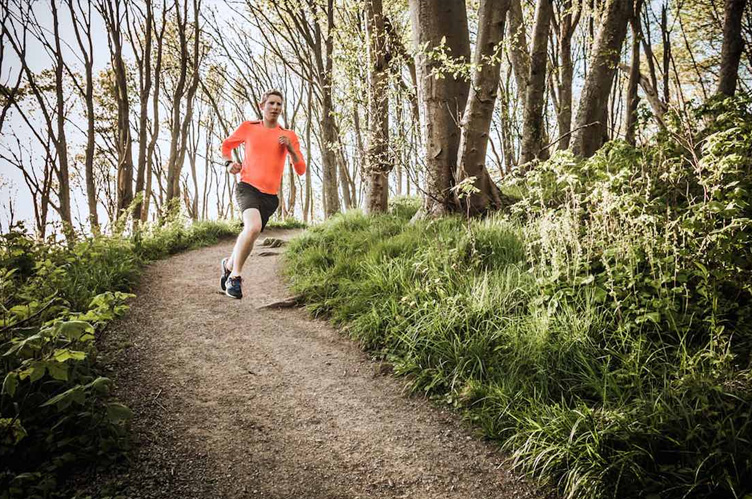
Note: ШӘЩ…ШұЫҢЩҶШ§ШӘ ШҜШұ ШҙЫҢШЁ ШЁШұ ЩҫШ§ЫҢЩҮ Ш§ЩҒЩҲШұШӘ ШЁЫҢШі (ШӘЩ„Ш§Шҙ Щ…ШӯЩҲШұ) ЩҮШіШӘЩҶШҜ ЩҲ ЩҶЩҮ ШЁШұ ЩҫШ§ЫҢЩҮ ШіШұШ№ШӘ (ЩҲЫҢШҜЫҢЩҲ ШҜШұ Ш§ЫҢЩҶШ¬Ш§). ШҙЩ…Ш§ ШҜШұ ШіШұШЁШ§Щ„Ш§ЫҢЫҢ ШўЩҮШіШӘЩҮвҖҢШӘШұ Щ…ЫҢвҖҢШҜЩҲЫҢШҜШҢ Ш§Щ…Ш§ Щ…Ш№ЫҢШ§Шұ Ш§ШөЩ„ЫҢ Ш§ЫҢЩҶ Ш§ШіШӘ Ъ©ЩҮ ШЁШ§ЫҢШҜ ШӘЩ„Ш§ШҙШӘШ§ЩҶ Щ…Ш§ЩҶЩҶШҜ ЫҢЪ© Щ…ШіШ§ШЁЩӮЩҮ Щ…ШҙШ®Шө ШЁШ§ШҙШҜ.
ШЁЩҮ Ш№ЩҶЩҲШ§ЩҶ Щ…Ш«Ш§Щ„ШҢ ШҜШұ ШҙЫҢШЁ Ш·ЩҲЩ„Ш§ЩҶЫҢ Ш§ШҙШ§ШұЩҮ ШҙШҜЩҮ ШҜШұ ШЁШ§Щ„Ш§ШҢ ШӘЩ…ШұЫҢЩҶШ§ШӘ ШіШ®ШӘЫҢ Щ…ШӯЩҲШұ Щ…ШіШ§ШЁЩӮЩҮ 10K Щ„Ш§ШІЩ… Ш§ШіШӘ ЩҶЩҮ ШіШұШ№ШӘ Щ…ШіШ§ШЁЩӮЩҮ 10K.
ШұЩҲЫҢ ЩҒШұЩ… Ш®ЩҲШЁ ШЁШ§ ЩҫЩҲШҙвҖҢШўЩҒ ЩӮШҜШұШӘЫҢ ЩҲ ЪҶШұШ®Шҙ ЩӮШҜШұШӘЫҢ ШЁШ§ШІЩҲ ШӘЩ…ШұЪ©ШІ Ъ©ЩҶЫҢШҜ. ШЁШұШ§ЫҢ ШұЫҢЪ©Ш§ЩҲШұЫҢ Ъ©ШұШҜЩҶ ШҙЫҢШЁ ШұШ§ ШЁЩҮ ШўШұШ§Щ…ЫҢ ЩҫШ§ЫҢЫҢЩҶ ШЁШҜЩҲЫҢШҜ.
ЩҮЩ…ЪҶЩҶЫҢЩҶ Щ…ЫҢвҖҢШӘЩҲШ§ЩҶЫҢШҜ ШЁШ§ ШҜЩҲЫҢШҜЩҶ ШҜШұ ШіШұШ№ШӘ 10KШҢ ШӘЪ©ЩҶЫҢЪ© ШҜЩҲЫҢШҜЩҶ ШҜШұ ШҙЫҢШЁ Щ…ЩҶЩҒЫҢ Ш®ЩҲШҜ ШұШ§ ШӘЩ…ШұЫҢЩҶ Ъ©ЩҶЫҢШҜ. ШЁШҜЩҶ Ш®ЩҲШҜ ШұШ§ ШӘШӯШӘ Ъ©ЩҶШӘШұЩ„ ЩҶЪҜЩҮ ШҜШ§ШұЫҢШҜ ЩҲ Ш§ЫҢЩҶ ЩҫШ§ЫҢЫҢЩҶ ШўЩ…ШҜЩҶвҖҢЩҮШ§ ШұШ§ ШЁЩҮ ШӘШҜШұЫҢШ¬ Ш§Ш¶Ш§ЩҒЩҮ Ъ©ЩҶЫҢШҜ ШІЫҢШұШ§ Ш§ШӯШӘЩ…Ш§Щ„Ш§ЩӢ ШўШ®Шұ Ъ©Ш§Шұ ШҜШұШҜ Ш®ЩҲШ§ЩҮЫҢШҜ ШҜШ§ШҙШӘ.
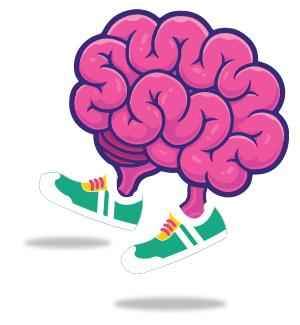
ШіШӘвҖҢЩҮШ§ЫҢ ШҙЫҢШЁвҖҢЩҮШ§ЫҢ Щ…ШӘЩҲШіШ· (Щ…ШҜЫҢЩҲЩ… ЩҮЫҢЩ„)
ШҙЫҢШЁвҖҢЩҮШ§ЫҢ Щ…ШӘЩҲШіШ· ШҜШұ ШіШұШ§ШІЫҢШұЫҢвҖҢЩҮШ§ЫҢ ЩҶШіШЁШӘШ§ЩӢ ШӘЩҶШҜ Ш§ЩҶШ¬Ш§Щ… Щ…ЫҢвҖҢШҙЩҲШҜ ЩҲ 45 ШӘШ§ 60 Ш«Ш§ЩҶЫҢЩҮ Ш·ЩҲЩ„ Щ…ЫҢвҖҢЪ©ШҙШҜ. ШӘЩ…ШұЫҢЩҶШ§ШӘ Ш§ЩҒЩҲШұШӘ ШЁЫҢШі (ШӘЩ„Ш§Шҙ Щ…ШӯЩҲШұ) ШҜШұ ШўЩҶ “ШіШ®ШӘ” Ш§ШіШӘ ЩҲ ШЁШұШ§ЫҢ Ш§Ъ©Ш«Шұ ШҜЩҲЩҶШҜЪҜШ§ЩҶ ШӯШҜЩҲШҜШ§ ШЁШ§ Щ…ШіШ§ШЁЩӮЩҮ 5K ШЁШұШ§ШЁШұЫҢ Щ…ЫҢвҖҢЪ©ЩҶШҜ. Щ…Ш§ЩҶЩҶШҜ ШҙЫҢШЁвҖҢЩҮШ§ЫҢ Ш·ЩҲЩ„Ш§ЩҶЫҢШҢ ШІЩ…Ш§ЩҶЫҢ Ъ©ЩҮ ШЁЩҮ ШЁШ§Щ„Ш§ ШҜШіШӘ ШұШіЫҢШҜЫҢШҜШҢ ШЁЩҮ ШіШ§ШҜЪҜЫҢ Щ…ЫҢвҖҢЪҶШұШ®ЫҢШҜ ЩҲ ЩӮШЁЩ„ Ш§ШІ ШҙШұЩҲШ№ ШіШӘ ШЁШ№ШҜЫҢШҢ ШЁШұШ§ЫҢ ШұЫҢЪ©Ш§ЩҲШұЫҢ Ъ©ШұШҜЩҶ ШҙЫҢШЁ ШұШ§ ШЁЩҮ ШўШұШ§Щ…ЫҢ ЩҫШ§ЫҢЫҢЩҶ Щ…ЫҢвҖҢШҜЩҲЫҢШҜ. ЩҮШҙШӘ ШӘШ§ 12 ШіШӘ ШЁШұШ§ЫҢ ШҙЫҢШЁвҖҢЩҮШ§ЫҢ Щ…ШӘШ№ШҜЩ„ Ш®ЩҲШЁ Ш§ШіШӘ.
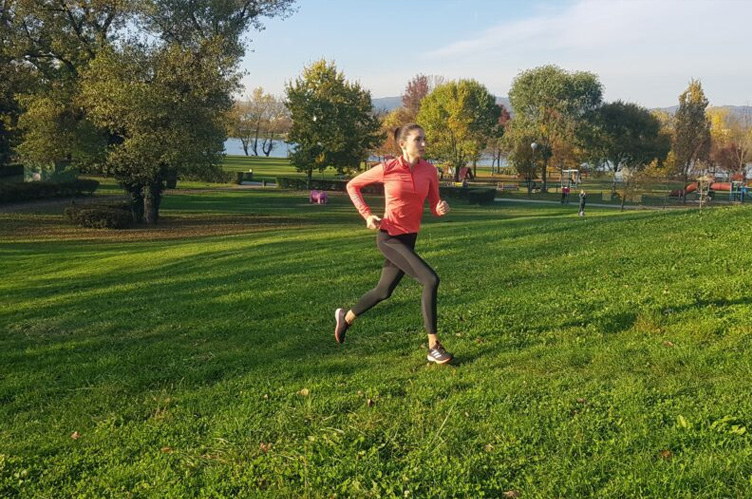 Note: ШЁШұШ®ЫҢ Ш§ШІ ШҜЩҲЩҶШҜЪҜШ§ЩҶ ШЁЩҮ ШӘЩ…ШұЫҢЩҶШ§ШӘ Щ…ШЁШӘЩҶЫҢ ШЁШұ Ш§ЩҒЩҲШұШӘ ШЁЫҢШі (ШіШ®ШӘЫҢ Щ…ШӯЩҲШұ) Ш№Ш§ШҜШӘ ЩҶШҜШ§ШұЩҶШҜШҢ ШЁЩҶШ§ШЁШұШ§ЫҢЩҶ ШҜШұ Ш§ЫҢЩҶШ¬Ш§ ЩҶШҙШ§ЩҶ Щ…ЫҢвҖҢШҜЩҮЫҢЩ… Ъ©ЩҮ ШӘЩ…ШұЫҢЩҶ ШҜШұ ШҙЫҢШЁ ЪҶЩҮ ШӯШіЩ‘ЫҢ ШҜШ§ШұШҜ. ШЁЫҢШ§ЫҢЫҢШҜ Ш§ШІ ШіШӘвҖҢЩҮШ§ЫҢ ШҙЫҢШЁ Щ…ШӘЩҲШіШ· ШЁЩҮ Ш№ЩҶЩҲШ§ЩҶ Щ…Ш«Ш§Щ„ Ш§ШіШӘЩҒШ§ШҜЩҮ Ъ©ЩҶЫҢЩ…. Ш§ЫҢЩҶ ШӘЩ…ШұЫҢЩҶ ШЁШ§ЫҢШҜ ШӯШіЫҢ ШҙШЁЫҢЩҮ ШЁЩҮ 5K ШҜШ§ШҙШӘЩҮ ШЁШ§ШҙШҜШҢ ШЁЩҶШ§ШЁШұШ§ЫҢЩҶ ЪҶЩҶШҜ ШіШӘ Ш§ЩҲЩ„ ШЁШ§ЫҢШҜ ШҙШЁЫҢЩҮ Ъ©ЫҢЩ„ЩҲЩ…ШӘШұЩҮШ§ЫҢ Ш§ЩҲЩ„ЫҢЩҮ 5K ШЁШ§ШҙШҜ – ШіШұЫҢШ№ Ш§Щ…Ш§ Ъ©ЩҶШӘШұЩ„ ШҙШҜЩҮ ЩҲ Щ…ЫҢвҖҢШӘЩҲШ§ЩҶЫҢШҜ ЩҶЩҒШі Ш®ЩҲШҜ ШұШ§ ШҜШұ ШҙЫҢШЁ Щ…ЩҶЩҒЫҢ ЩҲ ЩҮЩҶЪҜШ§Щ… ЩҶШұЩ… ШҜЩҲЫҢ ШұЫҢЪ©Ш§ЩҲШұЫҢ ШЁШ§ШІЫҢШ§ШЁЫҢ Ъ©ЩҶЫҢШҜ.
Note: ШЁШұШ®ЫҢ Ш§ШІ ШҜЩҲЩҶШҜЪҜШ§ЩҶ ШЁЩҮ ШӘЩ…ШұЫҢЩҶШ§ШӘ Щ…ШЁШӘЩҶЫҢ ШЁШұ Ш§ЩҒЩҲШұШӘ ШЁЫҢШі (ШіШ®ШӘЫҢ Щ…ШӯЩҲШұ) Ш№Ш§ШҜШӘ ЩҶШҜШ§ШұЩҶШҜШҢ ШЁЩҶШ§ШЁШұШ§ЫҢЩҶ ШҜШұ Ш§ЫҢЩҶШ¬Ш§ ЩҶШҙШ§ЩҶ Щ…ЫҢвҖҢШҜЩҮЫҢЩ… Ъ©ЩҮ ШӘЩ…ШұЫҢЩҶ ШҜШұ ШҙЫҢШЁ ЪҶЩҮ ШӯШіЩ‘ЫҢ ШҜШ§ШұШҜ. ШЁЫҢШ§ЫҢЫҢШҜ Ш§ШІ ШіШӘвҖҢЩҮШ§ЫҢ ШҙЫҢШЁ Щ…ШӘЩҲШіШ· ШЁЩҮ Ш№ЩҶЩҲШ§ЩҶ Щ…Ш«Ш§Щ„ Ш§ШіШӘЩҒШ§ШҜЩҮ Ъ©ЩҶЫҢЩ…. Ш§ЫҢЩҶ ШӘЩ…ШұЫҢЩҶ ШЁШ§ЫҢШҜ ШӯШіЫҢ ШҙШЁЫҢЩҮ ШЁЩҮ 5K ШҜШ§ШҙШӘЩҮ ШЁШ§ШҙШҜШҢ ШЁЩҶШ§ШЁШұШ§ЫҢЩҶ ЪҶЩҶШҜ ШіШӘ Ш§ЩҲЩ„ ШЁШ§ЫҢШҜ ШҙШЁЫҢЩҮ Ъ©ЫҢЩ„ЩҲЩ…ШӘШұЩҮШ§ЫҢ Ш§ЩҲЩ„ЫҢЩҮ 5K ШЁШ§ШҙШҜ – ШіШұЫҢШ№ Ш§Щ…Ш§ Ъ©ЩҶШӘШұЩ„ ШҙШҜЩҮ ЩҲ Щ…ЫҢвҖҢШӘЩҲШ§ЩҶЫҢШҜ ЩҶЩҒШі Ш®ЩҲШҜ ШұШ§ ШҜШұ ШҙЫҢШЁ Щ…ЩҶЩҒЫҢ ЩҲ ЩҮЩҶЪҜШ§Щ… ЩҶШұЩ… ШҜЩҲЫҢ ШұЫҢЪ©Ш§ЩҲШұЫҢ ШЁШ§ШІЫҢШ§ШЁЫҢ Ъ©ЩҶЫҢШҜ.
ШіШӘвҖҢЩҮШ§ЫҢ Щ…ЫҢШ§ЩҶЫҢ ШЁШ§ЫҢШҜ Щ…Ш§ЩҶЩҶШҜ Ъ©ЫҢЩ„ЩҲЩ…ШӘШұЩҮШ§ЫҢ ЩҲШіШ· ЫҢЪ© 5K Ш§ШӯШіШ§Ші ШҙЩҲШҜ – ШіШ®ШӘ ШҙШҜЩҶШҢ ШӘЩҶЩҒШі ШіШ®ШӘШҢ ЩҫШ§ЩҮШ§ Ш§ШӯШіШ§Ші ШіЩҶЪҜЫҢЩҶЫҢ Щ…ЫҢвҖҢЪ©ЩҶЩҶШҜ ЩҲ ШұЫҢЪ©Ш§ЩҲШұЫҢ ШҜШұ ШіШұШ§ШҙЫҢШЁЫҢ ШіШ®ШӘ ШӘШұ Щ…ЫҢвҖҢШҙЩҲШҜ. ШіШӘвҖҢЩҮШ§ЫҢ ШўШ®Шұ ШЁШ§ЫҢШҜ ШҙШЁЫҢЩҮ ШўШ®ШұЫҢЩҶ Ъ©ЫҢЩ„ЩҲЩ…ШӘШұЩҮШ§ЫҢ 5K ШЁШ§ШҙШҜ вҖ“ ЩҶЫҢШ§ШІ ЩҮШіШӘ ШЁЩҮ ШӘЩ…ШұЪ©ШІ Ш°ЩҮЩҶЫҢ ШЁШ§Щ„Ш§ ШЁШұШ§ЫҢ Ш§ШҜШ§Щ…ЩҮ ШҜШ§ШҜЩҶ ЩҲ Ш¬Щ„ЩҲЪҜЫҢШұЫҢ Ш§ШІ Ш§ШІ ЩҮЩ… ЪҜШіЫҢШ®ШӘЪҜЫҢ ЩҒШұЩ…ШӘШ§ЩҶ. ЩҶЩҒШі ШҙЩ…Ш§ ШЁШіЫҢШ§Шұ ШіЩҶЪҜЫҢЩҶ Ш§ШіШӘ ЩҲ Щ…Щ…Ъ©ЩҶ Ш§ШіШӘ ЩӮШЁЩ„ Ш§ШІ ЩҫШ§ЫҢЫҢЩҶ ШҜЩҲЫҢШҜЩҶ ШіШұШ§ШҙЫҢШЁЫҢ ШЁЩҮ ЪҶЩҶШҜ Ш«Ш§ЩҶЫҢЩҮ Ш§ШіШӘШұШ§ШӯШӘ ЩҶЫҢШ§ШІ ШҜШ§ШҙШӘЩҮ ШЁШ§ШҙЫҢШҜ.
ШіШӘвҖҢЩҮШ§ЫҢ ШҙЫҢШЁвҖҢЩҮШ§ЫҢ ШӘЩҶШҜ (Ш§ШіШӘЫҢЩҫ ЩҮЫҢЩ„)
ЩҮЩ…Ш§ЩҶШ·ЩҲШұ Ъ©ЩҮ Ш§ШІ ЩҶШ§Щ… ШўЩҶ ЩҫЫҢШҜШ§ШіШӘШҢ ШӘЩ…ШұЫҢЩҶШ§ШӘ ШҙЫҢШЁвҖҢЩҮШ§ЫҢ ШӘЩҶШҜ ШЁШұ ШұЩҲЫҢ ШҙЫҢШЁвҖҢЩҮШ§ЫҢ ШӘЩҶШҜ Ш§Ш¬ШұШ§ Щ…ЫҢвҖҢШҙЩҲЩҶШҜ. ШЁШ§ Ш§ЫҢЩҶ ШӯШ§Щ„ШҢ ШўЩҶЩҮШ§ ШӘЩҶЩҮШ§ 10 ШӘШ§ 15 Ш«Ш§ЩҶЫҢЩҮ Ш·ЩҲЩ„ Щ…ЫҢвҖҢЪ©ШҙЩҶШҜШҢ ШЁЩҶШ§ШЁШұШ§ЫҢЩҶ ШіШұЫҢШ№ ШЁШ§ ЩҫШ§ЫҢШ§ЩҶ Щ…ЫҢвҖҢШұШіЩҶШҜ. Ш§ШІ ШўЩҶШ¬Ш§ЫҢЫҢ Ъ©ЩҮ Ъ©ЩҲШӘШ§ЩҮ ЩҲ ШЁШ§ ШҙЫҢШЁ ШӘЩҶШҜ ЩҮШіШӘЩҶШҜШҢ Ш§ЩҒЩҲШұШӘ Ш§ЫҢЩҶ ШӘЩ…ШұЫҢЩҶШ§ШӘ ШЁШіЫҢШ§Шұ ШІЫҢШ§ШҜ ЩҲ ШіШ®ШӘ ЩҮШіШӘЩҶШҜ. (ЩҶШІШҜЫҢЪ© Ш§ЩҒЩҲШұШӘ ШҜЩҲЫҢШҜЩҶ ШЁШұШ§ЫҢ ШұЪ©ЩҲШұШҜ ЫҢЪ© Щ…Ш§ЫҢЩ„).

Ш§ЫҢШҜЩҮ ЩҫШҙШӘ ШіШӘвҖҢЩҮШ§ЫҢ Ш§ЫҢЩҶ ШҙЫҢШЁвҖҢЩҮШ§ЫҢ ШЁШіЫҢШ§Шұ Ъ©ЩҲШӘШ§ЩҮ ЩҲ ШӘЩҶШҜ Ш§ЫҢЩҶ Ш§ШіШӘ Ъ©ЩҮ ШҙЩ…Ш§ ШЁЩҮ ЩҶШҜШұШӘ ШӯШҜШ§Ъ©Ш«Шұ ЩӮШҜШұШӘ Ш№Ш¶Щ„Ш§ЩҶЫҢ Ш®ЩҲШҜ ШҜШұ ШӯЫҢЩҶ ШҜЩҲЫҢШҜЩҶ ШЁЩҮ Ш§ШіШӘЩҒШ§ШҜЩҮ Щ…ЫҢвҖҢЪ©ЩҶЫҢШҜ (ШӯШӘЫҢ ЩҮЩҶЪҜШ§Щ… ШҜЩҲЫҢШҜЩҶ ШіШұШ№ШӘЫҢ) ШЁЩҶШ§ШЁШұШ§ЫҢЩҶ Ш§ЫҢЩҶ ШӘЩ…ШұЫҢЩҶШ§ШӘ ШЁШ§ Ъ©Щ…Ъ© Ъ©ШұШҜЩҶ ШЁЩҮ ШӘЩӮЩҲЫҢШӘ ШЁЪ©Ш§ШұЪҜЫҢШұЫҢ Ъ©Ш§Щ…Щ„ Ш§ШІ ШұШҙШӘЩҮвҖҢЩҮШ§ЫҢ Ш№Ш¶Щ„Ш§ЩҶЫҢШҢ Ш§ШӯШӘЩ…Ш§Щ„Ш§ ШЁЩҮ ШЁЩҮШЁЩҲШҜ Ш№Щ…Щ„Ъ©ШұШҜ ЩҲ ЩҫЫҢШҙЪҜЫҢШұЫҢ Ш§ШІ ШўШіЫҢШЁ ЩҶЫҢШІ Ъ©Щ…Ъ© Щ…ЫҢвҖҢЪ©ЩҶЩҶШҜ.
ЩҫЫҢШіШӘ ШҙЫҢШЁвҖҢШҜШ§Шұ (ЩҮЫҢЩ„ ШіЫҢШұЪ©ШӘШі)
ЩҶЩҲШ№ Щ…ЩҲШұШҜ Ш№Щ„Ш§ЩӮЩҮ Щ…ЩҶ Ш§ШІ ШӘЩ…ШұЫҢЩҶШ§ШӘ ШҙЫҢШЁШҢ ЩҫЫҢШіШӘвҖҢЩҮШ§ЫҢ ШҙЫҢШЁвҖҢШҜШ§Шұ ЩҮШіШӘЩҶШҜ. Ш§ЫҢЩҶ ШӘЩ…ШұЫҢЩҶ ШӘЩҲШіШ· Щ…ШұШЁЫҢ Щ…ЩҶШҢ ШўШұШӘЩҲШұ Щ„ЫҢШҜЫҢШ§ШұШҜШҢ Ш№Щ…ЩҲЩ…ЫҢШӘ ЩҫЫҢШҜШ§ Ъ©ШұШҜШҢ ШЁЩҶШ§ШЁШұШ§ЫҢЩҶ Щ…ЩҶ ШЁЩҮ Ш·ЩҲШұ Ш·ШЁЫҢШ№ЫҢ ШЁЩҮ ШўЩҶ Ш№Щ„Ш§ЩӮЩҮ ШҜШ§ШұЩ…. ШҜШұ ЩҫЫҢШіШӘ ШҙЫҢШЁШҢ ШҙЩ…Ш§ ЩҶЩҮ ШӘЩҶЩҮШ§ Щ…Ш§ЩҶЩҶШҜ ШіШ§ЫҢШұ ШӘЩ…ШұЫҢЩҶШ§ШӘ ШҜШұ ШҙЫҢШЁ Щ…ЫҢвҖҢШҜЩҲЫҢШҜШҢ ШЁЩ„Ъ©ЩҮ Ш№ЩҶШ§ШөШұ ШҜЫҢЪҜШұЫҢ ШұШ§ ЩҶЫҢШІ ШҜШұ ШіШұШ§ШіШұ Щ…ШіЫҢШұ ЩҫЫҢШіШӘ ЩӮШұШ§Шұ ШҜШұ ЩҶШёШұ Щ…ЫҢвҖҢЪҜЫҢШұЫҢШҜ.
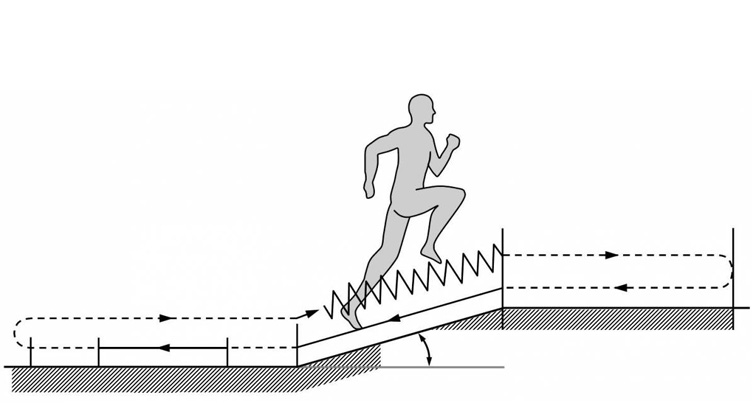
ШҜШұ ЩҫЫҢШіШӘ ШҙЫҢШЁвҖҢШҜШ§Шұ Щ…Ш№ШұЩҲЩҒ Щ„ЫҢШҜЫҢШ§ШұШҜШҢ ШҜЩҲЩҶШҜЪҜШ§ЩҶ ШҙЫҢШЁвҖҢЩҮШ§ЫҢ Щ…ШӘЩҲШіШ· ШұШ§ ЩӮШҜШұШӘЫҢ Щ…ЫҢвҖҢШҜЩҲЫҢШҜЩҶШҜ ЩҲ ШіЩҫШі ШҜШұ ШЁШ§Щ„Ш§ЫҢ ШҙЫҢШЁ Ш§ШіШӘШұШ§ШӯШӘ Щ…ЫҢвҖҢЪ©ЩҶЩҶШҜ. ЩҫШі Ш§ШІ ШұЫҢЪ©Ш§ЩҲШұЫҢ ЩҲ ЩӮШЁЩ„ Ш§ШІ ШҜЩҲЫҢШҜЩҶ ШҙЫҢШЁ Щ…ЩҶЩҒЫҢШҢ ШўЩҶЩҮШ§ ЪҶЩҶШҜЫҢЩҶ ЪҜШ§Щ… ШіШұШ№ШӘЫҢ Ъ©ЩҲШӘШ§ЩҮ ШЁШұШ§ЫҢ Ш§ЩҒШІШ§ЫҢШҙ ШіШұШ№ШӘ ЩҫШ§ ШЁШұЩ…ЫҢШҜШ§ШұЩҶШҜ. ШІЩ…Ш§ЩҶЫҢ Ъ©ЩҮ ШЁЩҮ ЩҫШ§ЫҢЫҢЩҶ ШұШіЫҢШҜЩҶШҜШҢ ЩӮШЁЩ„ Ш§ШІ Ш§ШіШӘШұШ§ЫҢШҜ ЩҮШ§ЫҢ ШЁЫҢШҙШӘШұ ШҜЩҲШЁШ§ШұЩҮ Ш§ШіШӘШұШ§ШӯШӘ Щ…ЫҢвҖҢЪ©ЩҶЩҶШҜ. Ш§ЪҜШұ Щ…ШіЫҢШұЩҮШ§ЫҢЫҢ ШҜШ§ШұЫҢШҜ Ъ©ЩҮ ШҜШұ ШЁШ§Щ„Ш§ ЩҲ ЩҫШ§ЫҢЫҢЩҶ ШіШ·Шӯ В ШөШ§ЩҒ ШҜШ§ШұЩҶШҜШҢ ШӘЩҲШөЫҢЩҮ Щ…ЫҢвҖҢЪ©ЩҶЩ… ЩҫЫҢШіШӘ ШҙЫҢШЁ Щ„ЫҢШҜЫҢШ§ШұШҜ ШұШ§ ШҜШұ ШЁШұЩҶШ§Щ…ЩҮ Ш®ЩҲШҜ ЩӮШұШ§Шұ ШҜЩҮЫҢШҜ.
ШҙЫҢШЁвҖҢЩҶЩҲШұШҜЫҢ Ш·ЩҲЩ„Ш§ЩҶЫҢ (Щ„Ш§ЩҶЪҜ ЩҮЫҢЩ„ Ъ©Щ„Ш§ЫҢЩ…ШЁ)
ШӘЩ…ШұЫҢЩҶ Щ…Ш№Щ…ЩҲЩ„ ЩҲШұШІШҙЪ©Ш§ШұШ§ЩҶ ШҜШұ Ш§ЩҲЩ„ЫҢЩҶ ШӘЫҢЩ… ШӘЩ…ШұЫҢЩҶЫҢ Ш§Щ„Щ…ЩҫЫҢЪ© Ъ©ЩҮ Щ…ЩҶ Щ…ШұШЁЫҢЪҜШұЫҢ Ъ©ШұШҜЩ…ШҢ ШҙЫҢШЁвҖҢЩҶЩҲШұШҜЫҢ Ш§ШіШӘЩӮШ§Щ…ШӘЫҢ ШЁЩҲШҜ. ШҜШұ Ъ©Щ…Щҫ Щ…Ш§ЩҶШҢ Щ…Ш§ ЫҢЪ© ШҙЫҢШЁ 20K ШҜШ§ШҙШӘЫҢЩ… Ъ©ЩҮ ЩҲШұШІШҙЪ©Ш§ШұШ§ЩҶ ЩҮЩҒШӘЩҮ Ш§ЫҢ ЫҢЪ© ШЁШ§Шұ ШўЩҶ ШұШ§ Щ…ЫҢвҖҢШҜЩҲЫҢШҜЩҶШҜ. Ш§ЫҢЩҶ ЫҢЪ© Щ…ШіШ§ШЁЩӮЩҮ ЩҶШЁЩҲШҜШҢ ШЁЩ„Ъ©ЩҮ Ш§ЩҒЩҲШұШӘЫҢ ШЁЩҲШҜ ШЁШіЫҢШ§Шұ ШҙШҜЫҢШҜ Ъ©ЩҮ ШЁЫҢШҙ Ш§ШІ ЫҢЪ© ШіШ§Ш№ШӘ Ш·ЩҲЩ„ Ъ©ШҙЫҢШҜ.
Ш§Ъ©Ш«Шұ Щ…ШұШЁЫҢШ§ЩҶ ШҜШұЫҢШ§ЩҒШӘЩҮ Ш§ЩҶШҜ Ъ©ЩҮ ЩҮШұ ШҙЫҢШЁвҖҢЩҶЩҲШұШҜЫҢ Ш§ШіШӘЩӮШ§Щ…ШӘЫҢ Ъ©ЩҮ ШЁЫҢЩҶ 30 ШҜЩӮЫҢЩӮЩҮ ШӘШ§ ЫҢЪ© ШіШ§Ш№ШӘ Ш·ЩҲЩ„ Щ…ЫҢвҖҢЪ©ШҙШҜ Ш№Ш§Щ„ЫҢ Ш№Щ…Щ„ Щ…ЫҢвҖҢЪ©ЩҶШҜ. Ш§Щ„ШЁШӘЩҮШҢ ШҙЩ…Ш§ ШЁШ§ЫҢШҜ ШЁЩҮ ЪҶЩҶЫҢЩҶ Щ…ШіЫҢШұ ШҙЫҢШЁвҖҢШҜШ§ШұЫҢ ШҜШіШӘШұШіЫҢ ШҜШ§ШҙШӘЩҮ ШЁШ§ШҙЫҢШҜШҢ ШЁЩҶШ§ШЁШұШ§ЫҢЩҶ Ш§ЫҢЩҶ ЩҶЩҲШ№ ШӘЩ…ШұЫҢЩҶ Щ…Ш№Щ…ЩҲЩ„Ш§ЩӢ ЩҒЩӮШ· ШЁШұШ§ЫҢ ШҜЩҲЩҶШҜЪҜШ§ЩҶ ШіШ§Ъ©ЩҶ ШҜШұ Щ…ЩҶШ§Ш·ЩӮ Ъ©ЩҲЩҮШіШӘШ§ЩҶЫҢ ШҜШұ ШҜШіШӘШұШі Ш§ШіШӘ.
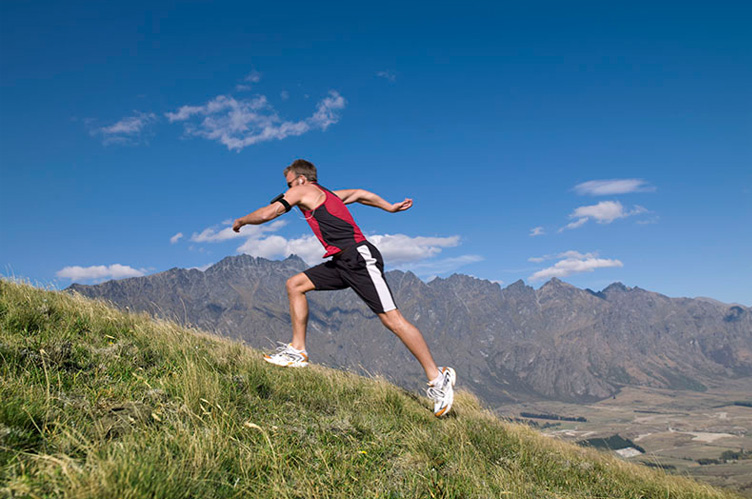
ШҜЩҲ ЩҫШұ ШҙЫҢШЁ (ЩҮЫҢЩ„ЫҢ ШұШ§ЩҶШІ)
Ш§Щ„ШЁШӘЩҮ ШіШ§ШҜЩҮ ШӘШұЫҢЩҶ ЩҶЩҲШ№ ШӘЩ…ШұЫҢЩҶ ШҜШұ ШҙЫҢШЁ ШЁШұШ§ЫҢ ЩҮЩ…ЩҮ ШҜЩҲЩҶШҜЪҜШ§ЩҶЫҢ Ъ©ЩҮ ШҜШұ Щ…ЩҶШ§Ш·ЩӮЫҢ ШЁШ§ ЩҫШіШӘЫҢ ШЁЩ„ЩҶШҜЫҢ ШІЫҢШ§ШҜ ШІЩҶШҜЪҜЫҢ Щ…ЫҢвҖҢЪ©ЩҶЩҶШҜ Ш§ЫҢЩҶ Ш§ШіШӘ Ъ©ЩҮ ЩҮШұ Ш§ШІ ЪҜШ§ЩҮЫҢ Ш§ЫҢЩҶ ШҜШұ ЩҮЩ…ЫҢЩҶ ЩҫШіШӘЫҢ ШЁЩ„ЩҶШҜЫҢ ЩҮШ§ ШЁШҜЩҲЩҶШҜ.
ЩҮЩҶЪҜШ§Щ… ШҜЩҲЫҢШҜЩҶ ШҜШұ ЫҢЪ© Щ…ШіЫҢШұ ЩҫШұ Ш§ШІ ЩҫШіШӘЫҢ ШЁЩ„ЩҶШҜЫҢШҢ ЪҜШ§ЩҮШ§ ШҙЫҢШЁвҖҢЩҮШ§ЫҢ Щ…Ш«ШЁШӘ ШұШ§ ЩҮШ¬ЩҲЩ…ЫҢ ШЁШҜЩҲЫҢШҜ ЩҲ ШҜШұ ШЁШұШ®ЫҢ Щ…ЩҲШ§ЩӮШ№ШҢ ШҙЫҢШЁвҖҢЩҮШ§ЫҢ Щ…ЩҶЩҒЫҢ ШұШ§ ШіШұЫҢШ№ШӘШұ ШЁШҜЩҲЫҢШҜ. ШЁШ§ ЪҜШ°ШҙШӘ ШІЩ…Ш§ЩҶШҢ Ш§ЫҢЩҶ Щ…ЩҲШ§Ш¬ЩҮЩҮ Щ…Ъ©ШұШұ ШЁШ§ ШҜЩҲЫҢШҜЩҶ ШҜШұ ШҙЫҢШЁ Щ…Ш«ШЁШӘ ЩҲ ШҙЫҢШЁ Щ…ЩҶЩҒЫҢ ШӘЩҶШ§ШіШЁ Ш§ЩҶШҜШ§Щ… ШҙЩ…Ш§ ШұШ§ ШӘШ§ ШӯШҜ ШІЫҢШ§ШҜЫҢ ШЁЩҮШЁЩҲШҜ Щ…ЫҢвҖҢШЁШ®ШҙШҜ.
ЩҒШұЩ… Щ…ЩҶШ§ШіШЁ ШҜЩҲЫҢШҜЩҶ ШҜШұ ШҙЫҢШЁ
ЩҮЫҢЪҶ ЩҒШұЩ… ШҜЩҲЫҢШҜЩҶ ШҜШұ ШҙЫҢШЁ (Щ…Ш«ШЁШӘ ЫҢШ§ Щ…ЩҶЩҒЫҢ) ЩҲШ§ШӯШҜЫҢ ШЁШұШ§ЫҢ ЩҮЩ…ЩҮ ШҜЩҲЩҶШҜЪҜШ§ЩҶ ЩҲШ¬ЩҲШҜ ЩҶШҜШ§ШұШҜ. Ш§Щ…Ш§ШҢ ШҙЩ…Ш§ ШЁШ§ЫҢШҜ ЩҒШұЩ…ЫҢ ШұШ§ ЩҫЫҢШҜШ§ Ъ©ЩҶЫҢШҜ Ъ©ЩҮ ШЁШұШ§ЫҢ ШҙЩ…Ш§ Щ…ЩҶШ§ШіШЁ ШӘШұ Ш§ШіШӘ. ШЁЩҶШ§ШЁШұШ§ЫҢЩҶШҢ Щ…ЩҶ ШҙЩ…Ш§ ШұШ§ ШӘШҙЩҲЫҢЩӮ Щ…ЫҢвҖҢЪ©ЩҶЩ… Ъ©ЩҮ ШҜШұ Ш·ЩҲЩ„ Ш§ЫҢЩҶ ШӘЩ…ШұЫҢЩҶШ§ШӘ ШЁШ§ ШӘЪ©ЩҶЫҢЪ©вҖҢЩҮШ§ЫҢ ШҜЩҲЫҢШҜЩҶ ШҜШұ ШҙЫҢШЁ Щ…Ш«ШЁШӘ ЩҲ ШҙЫҢШЁ Щ…ЩҶЩҒЫҢ Ш®ЩҲШҜ ШЁШ§ШІЫҢ Ъ©ЩҶЫҢШҜ.
ШҜШұ ШЁШұШ®ЫҢ ШіШӘ ЩҮШ§ ШЁШҜЩҶШӘШ§ЩҶ ШұШ§ ШЁЩҮ Ш¬Щ„ЩҲ Щ…ШӘЩ…Ш§ЫҢЩ„ Ъ©ЩҶЫҢШҜ ШҜШұ ШЁШұШ®ЫҢ ШҜЫҢЪҜШұ ШЁЫҢШҙШӘШұ ШЁЩҮ Ш№ЩӮШЁ. ШЁЩҮ Ш§ЫҢЩҶ ЩҒЪ©Шұ Ъ©ЩҶЫҢШҜ Ъ©ЩҮ ШІШ§ЩҶЩҲЩҮШ§ЫҢ Ш®ЩҲШҜ ШұШ§ ШҜШұ ШЁШұШ®ЫҢ Щ…ЩҲШ§ЩӮШ№ ШЁЩҮ Ш¬Щ„ЩҲ ЩҲ ШіЩҫШі ШҜШұ ШіШӘ ЩҮШ§ЫҢ ШҜЫҢЪҜШұШҢ ШұЩҲЫҢ ШЁЩҮ Ш№ЩӮШЁ Ш¶ШұШЁЩҮ ШІШҜЩҶ ШӘЩ…ШұЪ©ШІ Ъ©ЩҶЫҢШҜ.
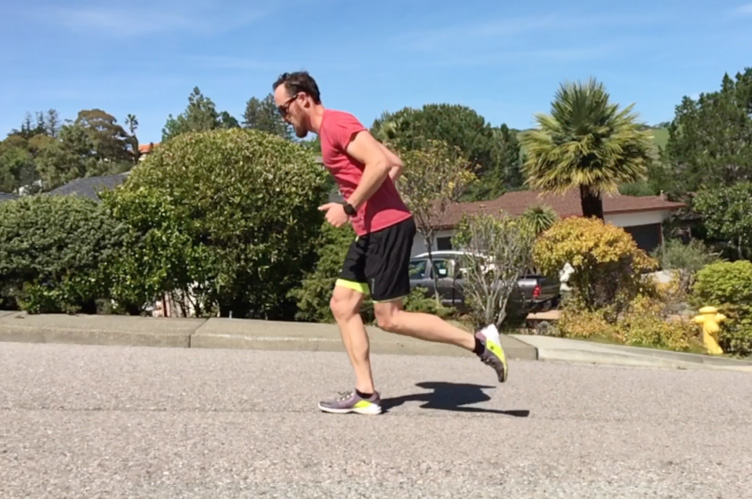 ЩҮЩ…ЫҢЩҶ Ъ©Ш§Шұ ШұШ§ ШЁШ§ ШҜШіШӘШ§ЩҶ Ш®ЩҲШҜ Ш§ЩҶШ¬Ш§Щ… ШҜЩҮЫҢШҜ (ШҜШұ ШЁШұШ®ЫҢ Щ…ЩҲШ§ЩӮШ№ ШЁШ§Щ„Ш§ Ъ©ШӘЩҒ ШЁШІЩҶЫҢШҜ ЩҲ ШЁШұШ®ЫҢ Щ…ЩҲШ§ЩӮШ№ ЩҫШ§ЫҢЫҢЩҶ). ШЁШ§ШІЫҢ ШЁШ§ШІЫҢ Ъ©ЩҶЫҢШҜ. ШўШІЩ…Ш§ЫҢШҙ Ъ©ЩҶЫҢШҜ. ШЁШЁЫҢЩҶЫҢШҜ ЪҶЩҮ ЪҶЫҢШІЫҢ ШЁШұШ§ЫҢ ШҙЩ…Ш§ Ъ©Ш§Шұ Щ…ЫҢвҖҢЪ©ЩҶШҜ.
ЩҮЩ…ЫҢЩҶ Ъ©Ш§Шұ ШұШ§ ШЁШ§ ШҜШіШӘШ§ЩҶ Ш®ЩҲШҜ Ш§ЩҶШ¬Ш§Щ… ШҜЩҮЫҢШҜ (ШҜШұ ШЁШұШ®ЫҢ Щ…ЩҲШ§ЩӮШ№ ШЁШ§Щ„Ш§ Ъ©ШӘЩҒ ШЁШІЩҶЫҢШҜ ЩҲ ШЁШұШ®ЫҢ Щ…ЩҲШ§ЩӮШ№ ЩҫШ§ЫҢЫҢЩҶ). ШЁШ§ШІЫҢ ШЁШ§ШІЫҢ Ъ©ЩҶЫҢШҜ. ШўШІЩ…Ш§ЫҢШҙ Ъ©ЩҶЫҢШҜ. ШЁШЁЫҢЩҶЫҢШҜ ЪҶЩҮ ЪҶЫҢШІЫҢ ШЁШұШ§ЫҢ ШҙЩ…Ш§ Ъ©Ш§Шұ Щ…ЫҢвҖҢЪ©ЩҶШҜ.
ЩҒШұЩ… ШҜЩҲЫҢШҜЩҶ ШҜШұ ШҙЫҢШЁ Щ…Ш«ШЁШӘ
ЪҶЩҮШ§Шұ ЩҶЪ©ШӘЩҮ Ъ©Щ„ЫҢШҜЫҢ ШЁШұШ§ЫҢ ШЁЩҮШЁЩҲШҜ ЩҒШұЩ… ШҜЩҲЫҢШҜЩҶ ШҜШұ ШҙЫҢШЁ Щ…Ш«ШЁШӘ ЩҲШ¬ЩҲШҜ ШҜШ§ШұШҜ:
ЩҲШ¶Ш№ЫҢШӘ ШЁШҜЩҶ
ШЁШұ Ш®Щ„Ш§ЩҒ Ш¬ЩҮШӘ ШҙЫҢШЁ Щ…ШӘЩ…Ш§ЫҢЩ„ ШҙЩҲЫҢШҜ ЩҲ ШҜШұ ЩҲШ§ЩӮШ№ ШЁЩҮ ШҙЫҢШЁ ШӘЪ©ЫҢЩҮ Ъ©ЩҶЫҢШҜ. ШҙЩ…Ш§ ЩҮЩҶЩҲШІ ЩҮЩ… Щ…ЫҢ Ш®ЩҲШ§ЩҮЫҢШҜ ШұШ§ШіШӘ ШЁШҜЩҲЫҢШҜШҢ Ш§Щ…Ш§ ШЁШҜЩҶ ШҙЩ…Ш§ ШЁШ§ЫҢШҜ ШҜШұ ШӯЫҢЩҶ ШҜЩҲЫҢШҜЩҶ ШЁЩҮ ШҙЫҢШЁ Щ…ШіЫҢШұ ШӘЪ©ЫҢЩҮ ШҜЩҮШҜ. ЩҮЩ…ЪҶЩҶЫҢЩҶШҢ ШӯШӘЩ…Ш§ ШЁЩҮ ШЁШ§Щ„Ш§ ЩҶЪҜШ§ЩҮ Ъ©ЩҶЫҢШҜ. ШӘЩ…Ш§ЫҢЩ„ Ш§ЫҢЩҶ Ш§ШіШӘ Ъ©ЩҮ ШЁЩҮ ШІЩ…ЫҢЩҶ ЩҶЪҜШ§ЩҮ Ъ©ЩҶЫҢШҜ Ш§Щ…Ш§ ЪҶШҙЩ…Ш§ЩҶ ЩҲ ШіШұ Ш®ЩҲШҜ ШұШ§ ШЁШ§Щ„Ш§ ЩҶЪҜЩҮ ШҜШ§ШұЫҢШҜ. ШЁЩҮ ШЁШ§Щ„Ш§ЫҢ ШҙЫҢШЁ ЩҶЪҜШ§ЩҮ Ъ©ЩҶЫҢШҜШҢ Щ…ШӘЩҲШ¬ЩҮ Ш®ЩҲШ§ЩҮЫҢШҜ ШҙШҜ Ъ©ЩҮ ШҜШұ ШӯШ§Щ„ШӘ ШұШ§ШіШӘ ШҜЩҲЫҢШҜЩҶ Ш®ЩҲШҜ Щ…ЫҢвҖҢЩ…Ш§ЩҶЫҢШҜ ЩҲ ШЁЩҮ ШҜШұШіШӘЫҢ ШЁЩҮ ШҙЫҢШЁ ШӘЪ©ЫҢЩҮ Щ…ЫҢвҖҢШҜЩҮЫҢШҜ.
 ШӯШұЪ©ШӘ ШҜШіШӘ
ШӯШұЪ©ШӘ ШҜШіШӘ
ЩҫШ§ЩҮШ§ ЩҮЩ…Ш§ЩҶ Ъ©Ш§ШұЫҢ ШұШ§ Щ…ЫҢвҖҢЪ©ЩҶЩҶШҜ Ъ©ЩҮ ШҜШіШӘ ЩҮШ§ Ш§ЩҶШ¬Ш§Щ… Щ…ЫҢвҖҢШҜЩҮЩҶШҜ. ШЁШ§ ШӯШұЪ©ШӘ ШҜШ§ШҜЩҶ ШҙШҜШӘ ШЁШ§ШІЩҲЩҮШ§ЫҢ Ш®ЩҲШҜ ШЁЩҮ ШіЩ…ШӘ ШЁШ§Щ„Ш§ЫҢ ШҙЫҢШЁ Щ…ЫҢвҖҢШӘЩҲШ§ЩҶЫҢШҜ ШЁЩҮШӘШұ ШіШұШ№ШӘ Ш®ЩҲШҜ ШұШ§ ШӯЩҒШё Ъ©ЩҶЫҢШҜ.
ШўЩҮЩҶЪҜ ЩҲ ШұЫҢШӘЩ… (Cadence)
ЪҜШ§Щ…вҖҢЩҮШ§ЫҢ ШіШұЫҢШ№вҖҢШӘШұ ЩҲ Ъ©ЩҲШӘШ§ЩҮвҖҢШӘШұ Щ…Ш№Щ…ЩҲЩ„Ш§ЩӢ ШЁЩҮШӘШұ Ш§ШІ ЪҜШ§Щ…вҖҢЩҮШ§ЫҢ ШЁЩ„ЩҶШҜ ШҜШұ ШҙЫҢШЁ Щ…Ш«ШЁШӘ Ш§ШіШӘ.
ЩҫШ§ЩҮШ§ ЫҢШ§ ШІШ§ЩҶЩҲЩҮШ§
ШЁШ§ ЩҶЫҢШұЩҲЫҢ ШӯШ§ШөЩ„ Ш§ШІ ШЁЩ„ЩҶШҜ Ъ©ШұШҜЩҶ ШІШ§ЩҶЩҲЩҮШ§ЫҢ Ш®ЩҲШҜ ШЁШұШ§ЫҢ ШЁШ§Щ„Ш§ ШұЩҒШӘЩҶ Ш§ШІ ШҙЫҢШЁ Щ…Ш«ШЁШӘ Ш§ШіШӘЩҒШ§ШҜЩҮ Ъ©ЩҶЫҢШҜ ЩҲ ЫҢШ§ ЪҜШІЫҢЩҶЩҮ ШҜЫҢЪҜШұ Ш§ЫҢЩҶ Ш§ШіШӘ Ъ©ЩҮШҢ ШЁШ№Ш¶ЫҢ Ш§ШІ ШҜЩҲЩҶШҜЪҜШ§ЩҶ Щ…ШӘЩҲШ¬ЩҮ Щ…ЫҢвҖҢШҙЩҲЩҶШҜ Ш§ЪҜШұ ШЁШ§ ЩҫШ§ЩҮШ§ЫҢ Ш®ЩҲШҜ ШЁЩҮ ШІЩ…ЫҢЩҶ ЩҒШҙШ§Шұ ЩҲШ§ШұШҜ Ъ©ЩҶЩҶШҜШҢ Ш№Щ…Щ„Ъ©ШұШҜ ШЁЩҮШӘШұЫҢ Ш®ЩҲШ§ЩҶШҜ ШҜШ§ШҙШӘ.
ШЁШұШ§ЫҢ Ш¬ШІШҰЫҢШ§ШӘ Ъ©Ш§Щ…Щ„ ЩҒШұЩ… ШҜЩҲЫҢШҜЩҶ ШҜШұ ШҙЫҢШЁ Щ…Ш«ШЁШӘШҢ ЩҲЫҢШҜЫҢЩҲ Ъ©Ш§Щ…Щ„ Щ…ЩҶ Ш§ЫҢЩҶШ¬Ш§ШіШӘ.
ЩҒШұЩ… ШҜЩҲЫҢШҜЩҶ ШҜШұ ШҙЫҢШЁ Щ…ЩҶЩҒЫҢ
ЩҲЩӮШӘЫҢ ШЁЩҮ ЩҒШұЩ… ШҜЩҲЫҢШҜЩҶ ШҜШұ ШҙЫҢШЁ Щ…ЩҶЩҒЫҢ Щ…ЫҢвҖҢШұШіЫҢЩ…ШҢ Ш§ЩҲШ¶Ш§Ш№ Ъ©Щ…ЫҢ Ш§ШІ ЩҒШұЩ… ШҜЩҲЫҢШҜЩҶ ШҜШұ ШҙЫҢШЁ Щ…Ш«ШЁШӘ ШӘШәЫҢЫҢШұ Щ…ЫҢвҖҢЪ©ЩҶШҜ.
ЩҲШ¶Ш№ЫҢШӘ ШЁШҜЩҶ
ШЁЩҮ Ш¬Ш§ЫҢ Ш§ЫҢЩҶЪ©ЩҮ Щ…Ш§ЩҶЩҶШҜ ШҜЩҲЫҢШҜЩҶ ШҜШұ ШҙЫҢШЁ Щ…Ш«ШЁШӘ ШЁЩҮ ШіЩ…ШӘ ШҙЫҢШЁ Щ…ШӘЩ…Ш§ЫҢЩ„ ШҙЩҲЫҢШҜШҢ ШҜШұ ШҙЫҢШЁвҖҢЩҮШ§ЫҢ Щ…ЩҶЩҒЫҢШҢ ШҙЩ…Ш§ ШЁЩҮ ШіЩ…ШӘ Ш®Щ„Ш§ЩҒ ШўЩҶ Щ…ШӘЩ…Ш§ЫҢЩ„ ШҙШҜЩҮ ЩҲ ШўЩҶ ШӘЪ©ЫҢЩҮ Щ…ЫҢвҖҢЪ©ЩҶЫҢШҜ. ШЁШ§ЫҢШҜ ШЁШҜЩҶ Ш®ЩҲШҜ ШұШ§ ШӘШ§ ШӯШҜ Ш§Щ…Ъ©Ш§ЩҶ Ш№Щ…ЩҲШҜ ШЁШұ ШІЩ…ЫҢЩҶ ЩҶЪҜЩҮ ШҜШ§ШұЫҢШҜ ШӘШ§ ШЁШӘЩҲШ§ЩҶЫҢШҜ “ШЁЩҮ Ш¬Ш§Ш°ШЁЩҮ ШІЩ…ЫҢЩҶ Ш§Ш¬Ш§ШІЩҮ ШҜЩҮЫҢШҜ Ш§ШІ ШіШұШ§ШҙЫҢШЁЫҢ ЩҫШ§ЫҢЫҢЩҶ ШЁШұШҜШӘШ§ЩҶ”. ШЁШұШ®ЫҢ Ш§ШІ ШҜЩҲЩҶШҜЪҜШ§ЩҶ Щ…ШӘЩҲШ¬ЩҮ Щ…ЫҢвҖҢШҙЩҲЩҶШҜ Ъ©ЩҮ Ш§ЪҜШұ ШЁШ§ШіЩҶ Ш®ЩҲШҜ ШұШ§ ШЁЩҮ ШіЩ…ШӘ Ш¬Щ„ЩҲ ШӯЩ„ ШҜЩҮЩҶШҜ ЫҢШ§ ШҙЩ…Ш§ ЩҒЪ©Шұ Ъ©ЩҶЫҢШҜ “Ш§ШІ Щ…ЪҶ ЩҫШ§ Ш®Щ… ШҙЩҲЫҢШҜ” ЩҲШ¶Ш№ЫҢШӘ ШЁЩҮШӘШұЫҢ ШЁШұШ§ЫҢ ШҜЩҲЫҢШҜЩҶ ШҜШұ ШҙЫҢШЁ Щ…ЩҶЩҒЫҢ ЩҫЫҢШҜШ§ Щ…ЫҢвҖҢЪ©ЩҶЩҶШҜ.
ШӯШұЪ©ШӘ ШҜШіШӘ
Ш§ШҙШӘШЁШ§ЩҮ ШЁШІШұЪҜЫҢ Ъ©ЩҮ ШҜЩҲЩҶШҜЪҜШ§ЩҶ ШҜШұ ШҙЫҢШЁ Щ…ЩҶЩҒЫҢ Щ…ШұШӘЪ©ШЁ Щ…ЫҢвҖҢШҙЩҲЩҶШҜ Ш§ЫҢЩҶ Ш§ШіШӘ Ъ©ЩҮ ШҜШіШӘвҖҢ ЩҲ ШҙШ§ЩҶЩҮвҖҢЩҮШ§ЫҢ Ш®ЩҲШҜ ШұШ§ ШЁШ§Щ„Ш§ Щ…ЫҢвҖҢШЁШұЩҶШҜ. Ш§ЫҢЩҶ ЫҢЪ© “ЩҶШЁШ§ЫҢШҜ” ШЁШІШұЪҜ Ш§ШіШӘ. ШҜШұ Ш№ЩҲШ¶ ШҜШіШӘвҖҢЩҮШ§ЫҢ Ш®ЩҲШҜ ШұШ§ ЩҫШ§ЫҢЫҢЩҶ ШЁЫҢШ§ЩҲШұЫҢШҜ. Ш§ЫҢЩҶ ШЁЩҮ ШҙЩ…Ш§ Ъ©Щ…Ъ© Щ…ЫҢЪ©ЩҶШҜ ШӘШ§ Ш§ШІ Щ…ШӘЩ…Ш§ЫҢЩ„ ШҙШҜЩҶ ШЁЩҮ ШіЩ…ШӘ Ш№ЩӮШЁ Ъ©ЩҮ ШҜШұ ШҙЫҢШЁвҖҢЩҮШ§ЫҢ Щ…ЩҶЩҒЫҢ ЫҢЪ© “ЩҶШЁШ§ЫҢШҜ” Ш®ЫҢЩ„ЫҢ Ш®ЫҢЩ„ЫҢ ШЁШІШұЪҜ Ш§ШіШӘ Ш¬Щ„ЩҲЪҜЫҢШұЫҢ Ъ©ЩҶЫҢШҜ.
ШўЩҮЩҶЪҜ ЩҲ ШұЫҢШӘЩ… (Cadence)
ЪҜШ§Щ…вҖҢЩҮШ§ЫҢ ШіШұЫҢШ№вҖҢШӘШұ ЩҲ Ъ©ЩҲШӘШ§ЩҮвҖҢШӘШұ Щ…Ш№Щ…ЩҲЩ„Ш§ЩӢ ШЁЩҮШӘШұ Ш§ШІ ЪҜШ§Щ…вҖҢЩҮШ§ЫҢ ШЁЩ„ЩҶШҜ ШҜШұ ШҙЫҢШЁ Щ…Ш«ШЁШӘ Ш§ШіШӘ. ЫҢЪ© ЪҜШ§Щ… ШЁЩ„ЩҶШҜ Ш§ШәЩ„ШЁ ШЁШ§Ш№Ш« Ш§ЩҒШІШ§ЫҢШҙ Ш§ЩҲШұ Ш§ШіШӘШұШ§ЫҢШҜ ЩҲ Ш§ЫҢШ¬Ш§ШҜ ЩҒШҙШ§Шұ ШІЫҢШ§ШҜЫҢ ШЁШұ ШұЩҲЫҢ ШіЫҢШіШӘЩ… Ш§ШіЪ©Щ„ШӘЫҢ Ш№Ш¶Щ„Ш§ЩҶЫҢ Щ…ЫҢвҖҢШҙЩҲШҜ. ШҜЩҲЩҶШҜЪҜШ§ЩҶ Ш§ШәЩ„ШЁ Щ…ШӘЩҲШ¬ЩҮ Щ…ЫҢвҖҢШҙЩҲЩҶШҜ Ъ©ЩҮ ШЁШұШ§ЫҢ Ш¬Щ„ЩҲЪҜЫҢШұЫҢ ШЁЩ„ЩҶШҜ ЪҜШ§Щ… ШЁШұШҜШ§ШҙШӘЩҶШҢ ШӘЩ…ШұЪ©ШІ ШұЩҲЫҢ ЩҒШұЩҲШҜ ШҜШұ Щ…ЫҢШ§ЩҶЩҮ ЩҫШ§ Щ…ЫҢвҖҢШӘЩҲШ§ЩҶШҜ Ъ©Щ…Ъ© Ъ©ЩҶЩҶШҜЩҮ ШЁШ§ШҙШҜ.
 ЩҮЩҶЪҜШ§ЩҶ ШҜЩҲЫҢШҜЩҶ ШұЩҲЫҢ ШЁШ§ШіЩҶ Ш®ЩҲШҜ ШӘЩ…ШұЪ©ШІ Ъ©ЩҶЫҢШҜ
ЩҮЩҶЪҜШ§ЩҶ ШҜЩҲЫҢШҜЩҶ ШұЩҲЫҢ ШЁШ§ШіЩҶ Ш®ЩҲШҜ ШӘЩ…ШұЪ©ШІ Ъ©ЩҶЫҢШҜ
ШҜШұ ШӯШ§Щ„ЫҢ Ъ©ЩҮ ШҜШұ ШҙЫҢШЁ Щ…Ш«ШЁШӘ ЩҮШіШӘЫҢШҜ ШЁЩҮ ШЁЩ„ЩҶШҜ Ъ©ШұШҜЩҶ ШІШ§ЩҶЩҲ ЩҮШ§ЫҢШӘШ§ЩҶ ЩҒЪ©Шұ Ъ©ЩҶЫҢШҜШҢ ШҜШұ ШҙЫҢШЁ Щ…ЩҶЩҒЫҢ ШЁШ§ЫҢШҜ ШЁЩҮ ЩҫШҙШӘ Ш®ЩҲШҜ ЩҒЪ©Шұ Ъ©ЩҶЫҢШҜ. ШӘЩ…ШұЪ©ШІ Ъ©ШұШҜЩҶ ШЁШұ ШұЩҲЫҢ” Щ…Ъ©Ш§ЩҶЫҢЪ© ШЁШ§ШіЩҶ” ШЁЩҮ ЩӮЩҲЩ„ ЪҜЩҒШӘЩҶЫҢШҢ ШЁЩҮ ШҙЩ…Ш§ Ъ©Щ…Ъ© Щ…ЫҢвҖҢЪ©ЩҶШҜ ШӘШ§ ШЁШұ ШҙЫҢШЁ Щ…ШіЩ„Ш· ШҙЩҲЫҢШҜ ЩҲ ШЁЩҮ Ш·ЩҲШұ Ъ©Щ„ЫҢ ШіШұШ№ШӘ ШЁЫҢШҙШӘШұЫҢ ШҜШұ ШҙЫҢШЁ Щ…ЩҶЩҒЫҢ ШҜШ§ШҙШӘЩҮ ШЁШ§ШҙЫҢШҜ.
ШіШұЫҢШ№ ЩҲ Ъ©Ш§ШұШўЩ…ШҜ
ШўШ®ШұЫҢЩҶ ЩҶЪ©ШӘЩҮ ШҜШұ ЩҒШұЩ… ШҜЩҲЫҢШҜЩҶ ШҜШұ ШҙЫҢШЁ Щ…ЩҶЩҒЫҢ Ш§ЫҢЩҶ Ш§ШіШӘ Ъ©ЩҮ ШҙЩ…Ш§ ШЁШ§ЫҢШҜ ШҜЩҲ Щ…ШҜЩ„ ШҜШ§ШҙШӘЩҮ ШЁШ§ШҙЫҢШҜ. ЩҶЩҲШ№ Ш§ЩҲЩ„ ШіШұЫҢШ№ ШҜЩҲЫҢШҜЩҶ Ш§ШіШӘ.
ШЁЩҮ Ш·ЩҲШұ Щ…Ш№Щ…ЩҲЩ„ШҢ Ш®Щ… ШҙШҜЩҶ ШЁЫҢШҙШӘШұ ШЁШ§ ШҙЫҢШЁ ЩҲ ШұЫҢШӘЩ… ШіШұЫҢШ№ШҢ ШЁШіЫҢШ§Шұ Ш№Ш§Щ„ЫҢ Ш№Щ…Щ„ Щ…ЫҢвҖҢЪ©ЩҶШҜ. Ш§ЫҢЩҶ ЩҶЩҲШ№ ЩҒШұЩ… ШҙЫҢШЁ Щ…ЩҶЩҒЫҢ ШЁШұШ§ЫҢ Щ…ШіШ§ШЁЩӮШ§ШӘЫҢ Ъ©ЩҮ ШҜШұ ШҙЫҢШЁ Щ…ЩҶЩҒЫҢ ШЁЩҮ ЩҫШ§ЫҢШ§ЩҶ Щ…ЫҢвҖҢШұШіЩҶШҜ Ш¶ШұЩҲШұЫҢ Ш§ШіШӘ. ШЁЩҮ ШіШұШ№ШӘ Ш§ШІ Ъ©ЩҶШ§Шұ ШіШ§ЫҢШұ ШҜЩҲЩҶШҜЪҜШ§ЩҶ Ш№ШЁЩҲШұ Ш®ЩҲШ§ЩҮЫҢШҜ Ъ©ШұШҜ.
ЩҶЩҲШ№ ШҜЩҲЩ… ЩҒШұЩ… ШҙЫҢШЁ Щ…ЩҶЩҒЫҢ Ъ©ЩҮ ШҙЩ…Ш§ ЩҶЫҢШ§ШІ ШҜШ§ШұЫҢШҜШҢ ЩҒШұЩ…ЫҢ Ш§ШіШӘ Ъ©ЩҮ Ъ©Ш§ШұШўЩ…ШҜ ШЁШ§ШҙШҜ ЩҲ ЩҒШҙШ§Шұ ЩҲШ§ШұШҜЩҮ ШЁШұ ШіЫҢШіШӘЩ… Ш§ШіЪ©Щ„ШӘЫҢ Ш№Ш¶Щ„Ш§ЩҶЫҢ ШұШ§ Ъ©Ш§ЩҮШҙ ШҜЩҮШҜ. ШҜЩҲЫҢШҜЩҶ ШҜШұ ШҙЫҢШЁ Щ…ЩҶЩҒЫҢ ЩҒШҙШ§Шұ ШЁЫҢШҙШӘШұЫҢ ШЁШұШ§ЫҢ ШЁШҜЩҶ ШҜШ§ШұШҜШҢ ШЁЩҶШ§ШЁШұШ§ЫҢЩҶ Ш§ЪҜШұ ШҜШұ ЫҢЪ© Щ…ШіШ§ШЁЩӮЩҮ Ш·ЩҲЩ„Ш§ЩҶЫҢ ШЁШ§ ШҙЫҢШЁ Щ…ЩҶЩҒЫҢ ШІЫҢШ§ШҜ Щ…ЫҢвҖҢШҜЩҲЫҢШҜ (ШЁЩҮ Щ…Ш§ШұШ§ШӘЩҶ ШЁЩҲШіШӘЩҲЩҶ ЩҒЪ©Шұ Ъ©ЩҶЫҢШҜ)ШҢ ШЁШ§ЫҢШҜ ЩҒШұЩ…ЫҢ ШұШ§ ШЁЫҢШ§ШЁЫҢШҜ Ъ©ЩҮ ШЁШұШ§ЫҢ ШЁШҜЩҶ ШҙЩ…Ш§ Щ…ЩҶШ§ШіШЁ Ш§ШіШӘ.
Ш§ЫҢЩҶ Щ…Щ…Ъ©ЩҶ Ш§ШіШӘ ШЁШ§ ЩҒШұЩ… ШіШұЫҢШ№ ШҙЩ…Ш§ ШҜШұ ШҙЫҢШЁ Щ…ЩҶЩҒЫҢ Щ…ШӘЩҒШ§ЩҲШӘ ШЁШ§ШҙШҜ Ш§Щ…Ш§ ЩӮШҜШұШӘ ЩҫШ§ЩҮШ§ЫҢ ШҙЩ…Ш§ ШұШ§ ШЁШұШ§ЫҢ Ш§ШҜШ§Щ…ЩҮ Щ…ШіШ§ШЁЩӮЩҮ ШӯЩҒШё Щ…ЫҢвҖҢЪ©ЩҶШҜ. ШўШІЩ…Ш§ЫҢШҙ Ъ©ЩҶЫҢШҜ ЩҲ ШЁШҜЩҶ Ш®ЩҲШҜ ШұШ§ Щ…ШҙШ§ЩҮШҜЩҮ Ъ©ЩҶЫҢШҜ. ШҙЩ…Ш§ ШЁЩҮ ШіШұШ№ШӘ ЩҒШұЩ…ЫҢ ШұШ§ ЩҫЫҢШҜШ§ Ш®ЩҲШ§ЩҮЫҢШҜ Ъ©ШұШҜ Ъ©ЩҮ ШҜШұ ШҙЫҢШЁвҖҢЩҮШ§ЫҢ Щ…ЩҶЩҒЫҢ ШЁШұШ§ЫҢ ШҙЩ…Ш§ Ъ©Ш§ШұШўЩ…ШҜШӘШұ ШЁШ§ШҙШҜ.
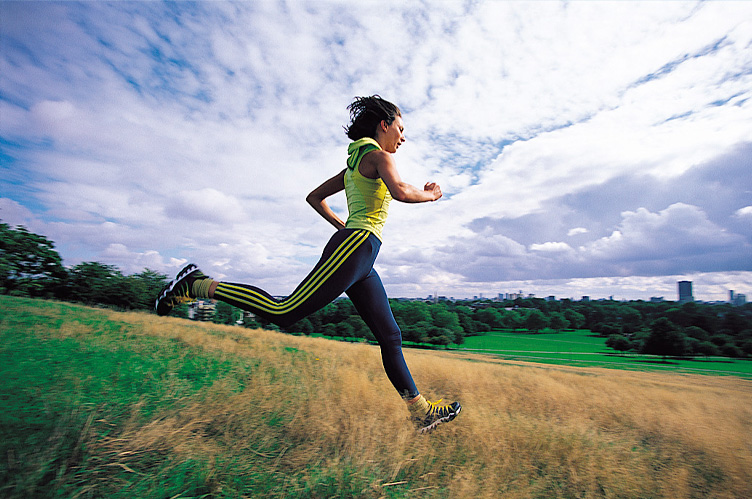 ШЁШұШ§ЫҢ Ш¬ШІШҰЫҢШ§ШӘ Ъ©Ш§Щ…Щ„ ШҜШұ Щ…ЩҲШұШҜ ЩҒШұЩ… ШҜЩҲЫҢШҜЩҶ ШҜШұ ШҙЫҢШЁ Щ…ЩҶЩҒЫҢШҢ ЩҲЫҢШҜЫҢЩҲЫҢ Ъ©Ш§Щ…Щ„ Щ…ЩҶ ШҜШұ Ш§ЫҢЩҶШ¬Ш§ ШўЩ…ШҜЩҮ Ш§ШіШӘ.
ШЁШұШ§ЫҢ Ш¬ШІШҰЫҢШ§ШӘ Ъ©Ш§Щ…Щ„ ШҜШұ Щ…ЩҲШұШҜ ЩҒШұЩ… ШҜЩҲЫҢШҜЩҶ ШҜШұ ШҙЫҢШЁ Щ…ЩҶЩҒЫҢШҢ ЩҲЫҢШҜЫҢЩҲЫҢ Ъ©Ш§Щ…Щ„ Щ…ЩҶ ШҜШұ Ш§ЫҢЩҶШ¬Ш§ ШўЩ…ШҜЩҮ Ш§ШіШӘ.
Ш§Ш¶Ш§ЩҒЩҮ Ъ©ШұШҜЩҶ ШҙЫҢШЁ ШЁЩҮ ШЁШұЩҶШ§Щ…ЩҮ Ш®ЩҲШҜ
ШӘЩ…ШұЫҢЩҶ ШӘШұЪ©ЫҢШЁЫҢ Ш§ЫҢШҜЩҮ ШўЩ„
ЩҮЩ…Ш§ЩҶШ·ЩҲШұ Ъ©ЩҮ ЩӮШЁЩ„Ш§ Ш§ШҙШ§ШұЩҮ ШҙШҜШҢ ШӘЩ…ШұЫҢЩҶШ§ШӘ ШҙЫҢШЁ ЩҫШі Ш§ШІ ШўЩҶ Ъ©ЩҮ ЩҫШ§ЫҢЩҮ ШҜЩҲЫҢШҜЩҶ Ш®ЩҲШҜ ШұШ§ ШіШ§Ш®ШӘЫҢШҜ ЩҲ ЩӮШЁЩ„ Ш§ШІ ШўЩҶЪ©ЩҮ ШЁЩҮ ШӘЩ…ШұЫҢЩҶШ§ШӘ ШіШұШ№ШӘЫҢ ШЁЩҫШұШҜШ§ШІЫҢШҜ ШЁШіЫҢШ§Шұ Ш№Ш§Щ„ЫҢ Ъ©Ш§Шұ Щ…ЫҢвҖҢЪ©ЩҶШҜ.
ШҜШұ Ш§ЫҢЩҶШ¬Ш§ ЫҢЪ© ШұШ§ЩҮ Щ…ШұШіЩҲЩ… ШЁШұШ§ЫҢ ШӘЩ…ШұЫҢЩҶ ШӘШұЪ©ЫҢШЁЫҢ ШҜЩҲЩҶШҜЪҜШ§ЩҶ ЩҶЫҢЩ… Щ…Ш§ШұШ§ШӘЩҶ ШҢЩ…Ш§ШұШ§ШӘЩҶ ЩҲ Ш§Щ„ШӘШұШ§Щ…Ш§ШұШ§ШӘЩҶ Ш®ЩҲШҜ ШұШ§ Ш°Ъ©Шұ Щ…ЫҢвҖҢЪ©ЩҶЩ…:
ЫҢЪ© Щ…ШіШ§ШЁЩӮЩҮ Ш§ШіШӘЩӮШ§Щ…ШӘЫҢ ШҜЫҢЪҜШұ ШҜШұ 6 Щ…Ш§ЩҮ
ШЁШұЩҶШ§Щ…ЩҮ ШұЫҢЪ©Ш§ЩҲШұЫҢ Щ…Ш§ШұШ§ШӘЩҶ ЩҲ ЩҶЫҢЩ…вҖҢЩ…Ш§ШұШ§ШӘЩҶ – ШӘШ§ 4 ЩҮЩҒШӘЩҮ
ШЁШұЩҶШ§Щ…ЩҮ ШӘЩ…ШұЫҢЩҶЫҢ ЩҫШ§ЫҢЩҮ – ШӘШ§ 8 ЩҮЩҒШӘЩҮ
ШӘЩ…ШұЫҢЩҶШ§ШӘ ШҙЫҢШЁ (Ш§Ш®ШӘЫҢШ§ШұЫҢ) – ШӘШ§ 6 ЩҮЩҒШӘЩҮ
ШӘЩ…ШұЫҢЩҶШ§ШӘ ШіШұШ№ШӘ (Ш§Ш®ШӘЫҢШ§ШұЫҢ) – ШӘШ§ 6 ЩҮЩҒШӘЩҮ
ШӘЩ…ШұЫҢЩҶШ§ШӘ ЩҶЫҢЩ…вҖҢЩ…Ш§ШұШ§ШӘЩҶШҢ Щ…Ш§ШұШ§ШӘЩҶ ЩҲ Ш§Щ„ШӘШұШ§ Щ…Ш§ШұШ§ШӘЩҶ – ШӘШ§ 16 ЩҮЩҒШӘЩҮ
Ъ©Щ„ Щ…ШҜШӘ ШӘЩ…ШұЫҢЩҶ = 16 ШӘШ§ 36 ЩҮЩҒШӘЩҮ
 Ш§ЩҲШ§ЫҢЩ„ ШЁШұЩҶШ§Щ…ЩҮ
Ш§ЩҲШ§ЫҢЩ„ ШЁШұЩҶШ§Щ…ЩҮ
ШЁШ№Ш¶ЫҢ Ш§ШІ ШҜЩҲЩҶШҜЪҜШ§ЩҶ ШІЩ…Ш§ЩҶ Щ„Ш§ШІЩ… ШЁШұШ§ЫҢ Ш§ЩҶШ¬Ш§Щ… Ъ©Ш§Щ…Щ„ ШЁШұЩҶШ§Щ…ЩҮ ШӘШұЪ©ЫҢШЁЫҢ ШұШ§ ЩҶШҜШ§ШұЩҶШҜ. ШҜШұ ЩҶШӘЫҢШ¬ЩҮ ЩҫЫҢШҙЩҶЩҮШ§ШҜ Щ…ЫҢШҜЩҮЩ… ШӘЩ…ШұЫҢЩҶШ§ШӘ ШҙЫҢШЁ ШұШ§ ШЁЩҮ Ш§ШЁШӘШҜШ§ЫҢ ШЁШұЩҶШ§Щ…ЩҮ ШӘЩ…ШұЫҢЩҶЫҢ Щ…ШіШ§ШЁЩӮЩҮ Ш®ЩҲШҜ Ш§Ш¶Ш§ЩҒЩҮ Ъ©ЩҶЫҢШҜ. 4 ШӘШ§ 5 ШӘЩ…ШұЫҢЩҶ ШҙЫҢШЁ ШұШ§ ШҜШұ 6 ЩҮЩҒШӘЩҮ Ш§ШЁШӘШҜШ§ЫҢЫҢ ШЁШұЩҶШ§Щ…ЩҮ Ш®ЩҲШҜ ЩҫШ®Шҙ Ъ©ЩҶЫҢШҜ. Ш§ЫҢЩҶ Ъ©Ш§Шұ Щ…ЩҲШ¬ШЁ Щ…ЫҢвҖҢШҙЩҲШҜ ШӘШ§ ШўЩ…Ш§ШҜЪҜЫҢ Щ…ЩҲШ§Ш¬ЩҮЩҮ ШЁШ§ ШЁШұЩҶШ§Щ…ЩҮ ШӘЩ…ШұЫҢЩҶШ§ШӘ Щ…Ш®ШӘШө Щ…ШіШ§ШЁЩӮЩҮ Ш®ЩҲШҜ ШұШ§ШҢ ШҜШұ 6 ШӘШ§ 8 ЩҮЩҒШӘЩҮ ШўШ®Шұ ШЁШ§Щ„Ш§ ШЁШЁШұЫҢШҜ.
Ш§ЪҜШұ Щ…ШіШ§ШЁЩӮЩҮ ЩҫШұ ШҙЫҢШЁ ШҜШ§ШұЫҢШҜ ШӘЩ…ШұЫҢЩҶШӘШ§ЩҶ ШұШ§ ЩҫШ®Шҙ Ъ©ЩҶЫҢШҜ
ШұЩҲШҙ ШҜЫҢЪҜШұЫҢ Ъ©ЩҮ Щ…ЩҶ ШӘЩ…ШұЫҢЩҶ ШҙЫҢШЁ ШұШ§ Ш§Ш¶Ш§ЩҒЩҮ Щ…ЫҢвҖҢЪ©ЩҶЩ… ШЁШұШ§ЫҢ ШҜЩҲЩҶШҜЪҜШ§ЩҶЫҢ Ш§ШіШӘ Ъ©ЩҮ Щ…ШіШ§ШЁЩӮЩҮ ЩҮШҜЩҒ ШҙШ§Щ…Щ„ ШҙЫҢШЁ Щ…ЫҢвҖҢШҙЩҲШҜ. Ш§ЪҜШұ Щ…ШіШ§ШЁЩӮЩҮ ШҙЩ…Ш§ ШҜШ§ШұШ§ЫҢ ШҙЫҢШЁвҖҢЩҮШ§ЫҢ ЩӮШ§ШЁЩ„ ШӘЩҲШ¬ЩҮЫҢ Ш§ШіШӘ ЩҲ ЫҢШ§ Ш§ШӯШіШ§Ші Щ…ЫҢвҖҢЪ©ЩҶЫҢШҜ Ъ©ЩҮ ШЁШ§ЫҢШҜ ШұЩҲЫҢ ШӘЪ©ЩҶЫҢЪ© ШҜЩҲЫҢШҜЩҶ ШҜШұ ШҙЫҢШЁ Ъ©Ш§Шұ Ъ©ЩҶЫҢШҜШҢ ШҜШұ ШіШұШ§ШіШұ ШЁШұЩҶШ§Щ…ЩҮ Щ…ШіШ§ШЁЩӮЩҮ Ш®ЩҲШҜ ШӘЩ…ШұЫҢЩҶШ§ШӘ ШҜЩҲЫҢШҜЩҶ ШҜШұ ШҙЫҢШЁ ШұШ§ ЩҫШ®Шҙ Ъ©ЩҶЫҢШҜ.
ЩҮШұ ЪҶЩҮ ШӘЩ…ШұЫҢЩҶ ШҙЫҢШЁ ШҙЩ…Ш§ ШЁШ§ ШІЩ…ЫҢЩҶ Щ…ШіШ§ШЁЩӮЩҮ Щ…Ш·Ш§ШЁЩӮШӘ ШҜШ§ШҙШӘЩҮ ШЁШ§ШҙШҜШҢ ШЁЩҮШӘШұ Ш§ШіШӘ.
Щ…ШіЫҢШұ ШҙЫҢШЁ ШҜШ§Шұ ЩҶШҜШ§ШұЫҢШҜШҹ
ШҜШұ Щ…ЩҶШ·ЩӮЩҮ Щ…ШіШ·Шӯ ШІЩҶШҜЪҜЫҢ Щ…ЫҢвҖҢЪ©ЩҶЫҢШҜ ЩҲЩ„ЫҢ ШҜШұ Щ…ШіШ§ШЁЩӮЩҮ ШЁШ§ Щ…ШіЫҢШұЩҮШ§ЫҢ ШҙЫҢШЁвҖҢШҜШ§Шұ ШҙШұЪ©ШӘ Щ…ЫҢвҖҢЪ©ЩҶЫҢШҜШҹ Ш§ЫҢЩҶ ЫҢЪ© ШіЩҲШ§Щ„ Щ…Ш№Щ…ЩҲЩ„ Ш§ШіШӘ Ъ©ЩҮ ШЁШ§ ШўЩҶ ШІЫҢШ§ШҜ Щ…ЩҲШ§Ш¬ЩҮ Щ…ЫҢвҖҢШҙЩҲЩ… ЩҲ ШҜЩҲ Ш¬ЩҲШ§ШЁ Ш®ЩҲШЁ ШЁШұШ§ЫҢ ШўЩҶ ЩҲШ¬ЩҲШҜ ШҜШ§ШұШҜ.
ШЁЩҮШӘШұЫҢЩҶ ШұШ§ЩҮ ШӯЩ„ ШӘЩ…ШұЫҢЩҶ ШҙЫҢШЁ ШұЩҲЫҢ ШӘШұШҜЩ…ЫҢЩ„ Ш§ШіШӘ. ШЁШ§ ШӘШәЫҢЫҢШұ ШӘЩҶШёЫҢЩ…Ш§ШӘ ШҙЫҢШЁ ШӘШұШҜЩ…ЫҢЩ„ ШЁЩҮ ШЁЩҮШӘШұЫҢЩҶ ШӯШ§Щ„ШӘ ШҙЫҢШЁЫҢ Ъ©ЩҮ Щ…ЫҢвҖҢШ®ЩҲШ§ЩҮЫҢШҜ ШЁШұШіЫҢШҜ. ЩҒЩӮШ· ЩҒШұШ§Щ…ЩҲШҙ ЩҶЪ©ЩҶЫҢШҜ ЩҲЩӮЩҒЩҮ Щ…ЩҲШ¬ЩҲШҜ ШҜШұ ШӘШәЫҢЫҢШұ Ш§ШІ ШҙЫҢШЁ Щ…Ш«ШЁШӘ ШЁЩҮ Щ…ЩҶЩҒЫҢ ЩҲ Ш§ШіШӘШұШ§ШӯШӘ Щ…Ш§ ШЁЫҢЩҶ ШўЩҶ ШЁШ§Ш№Ш« Щ…ЫҢвҖҢШҙЩҲШҜ ШҜЩҲЫҢШҜЩҶ ШұЩҲЫҢ ШӘШұЩ…ЫҢЩ„ ШҜШұ ЩҮШұ ШіШӘ ШіШ®ШӘвҖҢШӘШұ Ш§ШІ ШҜЩҲЫҢШҜЩҶ ШұЩҲЫҢ ШҙЫҢШЁ ЩҲШ§ЩӮШ№ЫҢ ШЁШ§ШҙШҜ.
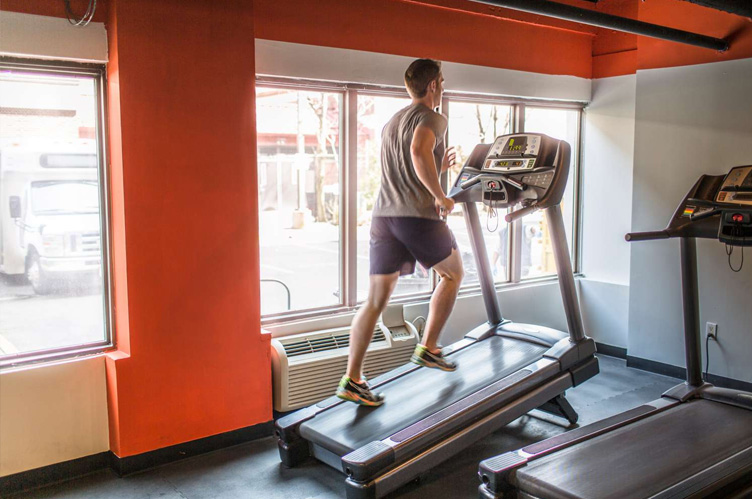 ШЁШ№Ш¶ЫҢ Ш§ШІ ШҜЩҲЩҶШҜЪҜШ§ЩҶ ШіШ§Ъ©ЩҶШ§ЩҶ Щ…ЩҶШ§Ш·ЩӮ Щ…ШіШ·Шӯ Ш§ШІ ЩҫШ§ШұЪ©ЫҢЩҶЪҜ ЩҲ ЩҫЩ„вҖҢЩҮШ§ ШЁШұШ§ЫҢ ШӘЩ…ШұЫҢЩҶШ§ШӘ ШҙЫҢШЁ Ш®ЩҲШҜ Ш§ШіШӘЩҒШ§ШҜЩҮ Щ…ЫҢвҖҢЪ©ЩҶЩҶШҜ. ЩҲШ§Ш¶Шӯ Ш§ШіШӘ Ъ©ЩҮ Ш§ЩҶШӘШ®Ш§ШЁвҖҢЩҮШ§ЫҢ Щ…ШӯШҜЩҲШҜЫҢ ШҜШ§ШұЫҢШҜ ЩҲЩ„ЫҢ Ш§ШІ ЩҮЫҢЪҶЫҢ ШЁЩҮШӘШұ Ш§ШіШӘ. Ш§ЪҜШұ ШЁЩҮ ЩҮЫҢЪҶ ШҙЫҢШЁЫҢ ШҜШіШӘШұШіЫҢ ЩҶШҜШ§ШұЫҢШҜ ШӘЩ…ШұЫҢЩҶШ§ШӘ ШҙЫҢШЁ Ш®ЩҲШҜ ШұШ§ ШЁЩҮ ЩҒШ§ШұШӘЩ„Ъ© (ШЁШ§ШІЫҢ ШЁШ§ ШіШұШ№ШӘ) ШӘШәЫҢЫҢШұ ШҜЩҮЫҢШҜ ЩҲ Ш§ШІ Щ„ШӯШ§Шё ШІЩ…Ш§ЩҶЫҢ ЩҲ Ш§ЩҒЩҲШұШӘ ЩҲ ШұЫҢЪ©Ш§ЩҲШұЫҢ ЩҲ ШӘШ№ШҜШ§ШҜ ШіШӘвҖҢЩҮШ§ ШӘШ·ШЁЫҢЩӮ ШҜЩҮЫҢШҜ.
ШЁШ№Ш¶ЫҢ Ш§ШІ ШҜЩҲЩҶШҜЪҜШ§ЩҶ ШіШ§Ъ©ЩҶШ§ЩҶ Щ…ЩҶШ§Ш·ЩӮ Щ…ШіШ·Шӯ Ш§ШІ ЩҫШ§ШұЪ©ЫҢЩҶЪҜ ЩҲ ЩҫЩ„вҖҢЩҮШ§ ШЁШұШ§ЫҢ ШӘЩ…ШұЫҢЩҶШ§ШӘ ШҙЫҢШЁ Ш®ЩҲШҜ Ш§ШіШӘЩҒШ§ШҜЩҮ Щ…ЫҢвҖҢЪ©ЩҶЩҶШҜ. ЩҲШ§Ш¶Шӯ Ш§ШіШӘ Ъ©ЩҮ Ш§ЩҶШӘШ®Ш§ШЁвҖҢЩҮШ§ЫҢ Щ…ШӯШҜЩҲШҜЫҢ ШҜШ§ШұЫҢШҜ ЩҲЩ„ЫҢ Ш§ШІ ЩҮЫҢЪҶЫҢ ШЁЩҮШӘШұ Ш§ШіШӘ. Ш§ЪҜШұ ШЁЩҮ ЩҮЫҢЪҶ ШҙЫҢШЁЫҢ ШҜШіШӘШұШіЫҢ ЩҶШҜШ§ШұЫҢШҜ ШӘЩ…ШұЫҢЩҶШ§ШӘ ШҙЫҢШЁ Ш®ЩҲШҜ ШұШ§ ШЁЩҮ ЩҒШ§ШұШӘЩ„Ъ© (ШЁШ§ШІЫҢ ШЁШ§ ШіШұШ№ШӘ) ШӘШәЫҢЫҢШұ ШҜЩҮЫҢШҜ ЩҲ Ш§ШІ Щ„ШӯШ§Шё ШІЩ…Ш§ЩҶЫҢ ЩҲ Ш§ЩҒЩҲШұШӘ ЩҲ ШұЫҢЪ©Ш§ЩҲШұЫҢ ЩҲ ШӘШ№ШҜШ§ШҜ ШіШӘвҖҢЩҮШ§ ШӘШ·ШЁЫҢЩӮ ШҜЩҮЫҢШҜ.
ШұШ§ЩҮ ШҜЫҢЪҜШұ ШұЩҒШӘЩҶ ШЁЩҮ ШЁШ§ШҙЪҜШ§ЩҮ Ш§ШіШӘ ЩҮШұ ШӘЩ…ШұЫҢЩҶ ЩҫШ§ ШЁЩҮ ШӘЩӮЩҲЫҢШӘ Ш№Ш¶Щ„Ш§ШӘ ЩҫШ§ Ъ©Щ…Ъ© Щ…ЫҢвҖҢЪ©ЩҶШҜ. Ш§ШіЪ©ЩҲШ§ШҜШҢ Щ„Ш§ЩҶЪҜШҢ Ш§ШіШӘЩҫ ШўЩҫ ЩҲ ШӘЩ…ШұЫҢЩҶШ§ШӘ ЩҫЩ„ЩҮвҖҢШ§ЫҢ ЩҲ ШҜЫҢЪҜШұ ШӘЩ…ШұЫҢЩҶШ§ШӘ ЩҫШ§ Щ…ЫҢвҖҢШӘЩҲШ§ЩҶШҜ Щ…ЩҒЫҢШҜ ШЁШ§ШҙШҜ. Ш§Щ„ШЁШӘЩҮ ЩҮШұЪҶЩҮ ШӘЩ…ШұЫҢЩҶШ§ШӘ ШЁЩҮ ШӯШұЪ©Ш§ШӘ Ш·ШЁЫҢШ№ЫҢ ШҜЩҲЫҢШҜЩҶ ЩҶШІШҜЫҢЪ©вҖҢШӘШұ ШЁШ§ШҙШҜ ШЁЩҮШӘШұ Ш§ШіШӘ.
ШӘЩ…ШұЫҢЩҶШ§ШӘ ШҙЫҢШЁ ШЁЩҮ Ш№ЩҶЩҲШ§ЩҶ ШӘЩ…ШұЫҢЩҶ ЩҫЩ„Ш§ЫҢЩҲЩ…ШӘШұЫҢЪ©
ШўШ®ШұЫҢЩҶ ШұЩҲШҙЫҢ Ъ©ЩҮ Ш§ШІ ШӘЩ…ШұЫҢЩҶШ§ШӘ ШҙЫҢШЁ Ш§ШіШӘЩҒШ§ШҜЩҮ Щ…ЫҢвҖҢШҙЩҲШҜ ШҜШұ ШӘЩ…ШұЫҢЩҶ ЩҫЩ„Ш§ЫҢЩҲЩ…ШӘШұЫҢЪ© Ш§ШіШӘ. ШўШұШӘЩҲШұ Щ„ЫҢШҜЫҢШ§ШұШҜ ЫҢЪ©ЫҢ Ш§ШІ ШЁШІШұЪҜШӘШұЫҢЩҶ Щ…ШұШЁЫҢШ§ЩҶ ШҜЩҶЫҢШ§ Ш§ЫҢЩҶ Ъ©Ш§Шұ ШұШ§ ШІЫҢШ§ШҜ Ш§ЩҶШ¬Ш§Щ… ШҜШ§ШҜЩҮ Ш§ШіШӘ. ШЁШ№ШҜ Ш§ШІ ШўЩҶЪ©ЩҮ ЩҫШ§ЫҢЩҮ Ш№Щ…Щ„Ъ©ШұШҜ ШіШ§Ш®ШӘЩҮ ШҙШҜ ШҜЩҲЩҶШҜЪҜШ§ЩҶ Щ…ШіЫҢШұ ЩҮШ§ЫҢ ШҙЫҢШЁвҖҢШҜШ§Шұ ШұШ§ ШҜШұЫҢЩ„ Щ…ЫҢвҖҢШҜЩҲЩҶШҜ ШӘШ§ ЩҫШ§ЩҮШ§ЫҢ Ш®ЩҲШҜ ШЁШұШ§ЫҢ ШіШ®ШӘЫҢвҖҢЩҮШ§ЫҢ ШӘЩ…ШұЫҢЩҶШ§ШӘ ШіШұШ№ШӘЫҢ ШўЩ…Ш§ШҜЩҮ Ъ©ЩҶЩҶШҜ. Ш§ЫҢЩҶ ШұЩҲШҙ ШЁШ§Ш№Ш« Ъ©Щ…Ъ© ШЁЩҮ Ъ©Ш§ЩҮШҙ ШўШіЫҢШЁвҖҢШҜЫҢШҜЪҜЫҢвҖҢЩҮШ§ ЩҲ ШЁШ§Щ„Ш§ ШұЩҒШӘЩҶ Ш№Щ…Щ„Ъ©ШұШҜ ШҜШұ ШӘЩ…ШұЫҢЩҶШ§ШӘ Щ…ШіШ§ШЁЩӮШ§ШӘ Щ…ЫҢвҖҢШҙЩҲШҜ.
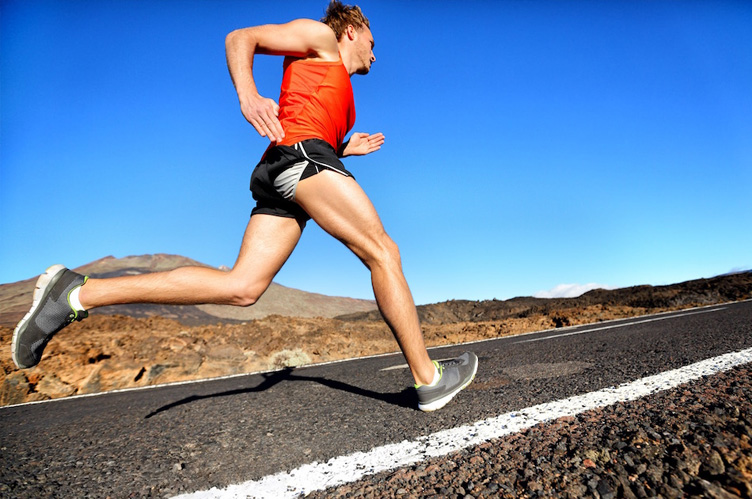 Щ„ЫҢШҜЫҢШ§ШұШҜ Ш§ШІ ШіЩҮ ЩҶЩҲШ№ ШӘЩ…ШұЫҢЩҶ ШҜШұЫҢЩ„ ШҜЩҲЫҢ Ш§ШіШӘЩҒШ§ШҜЩҮ Щ…ЫҢвҖҢЪ©ШұШҜ:
Щ„ЫҢШҜЫҢШ§ШұШҜ Ш§ШІ ШіЩҮ ЩҶЩҲШ№ ШӘЩ…ШұЫҢЩҶ ШҜШұЫҢЩ„ ШҜЩҲЫҢ Ш§ШіШӘЩҒШ§ШҜЩҮ Щ…ЫҢвҖҢЪ©ШұШҜ:
ШҜЩҲЫҢШҜЩҶ ШҜШұ ШҙЫҢШЁ
ШЁШ§ ШұЩҲШҙ Щ„ЫҢШҜЫҢШ§ШұШҜШҢ ШҙЩ…Ш§ ШЁШұШ§ЫҢ ШіШұЫҢШ№ ШҜЩҲЫҢШҜЩҶ ШҙЫҢШЁ Щ…Ш«ШЁШӘ ШұШ§ Ш·ЫҢ ЩҶЩ…ЫҢвҖҢЪ©ЩҶЫҢШҜ ШЁЩҮ Ш¬Ш§ЫҢ ШўЩҶ ШӘЩ…ШұЪ©ШІ ШЁШұ ШұЩҲЫҢ ЩҒШұЩ… ШҜЩҲЫҢШҜЩҶ ШҜШұ ШҜШұЫҢЩ„вҖҢЩҮШ§ЫҢ ШҙЫҢШЁ Ш§ШіШӘ. ШЁШұШ§ЫҢ Ш§ЩҶШ¬Ш§Щ… Ш§ЫҢЩҶ ШӘЩ…ШұЫҢЩҶШ§ШӘ ШҜЩҲЫҢШҜЩҶ ШҜШұ ШҙЫҢШЁ ЩҫЩ„Ш§ЫҢЩҲЩ…ШӘШұЫҢЪ©ШҢ ШЁЩҮ ШЁШ§Щ„Ш§ ШўЩҲШұШҜЩҶ ШІШ§ЩҶЩҲвҖҢЩҮШ§ ШӘЩҲШ¬ЩҮ Ъ©ЩҶЫҢШҜ ЩҲ Щ…ШіШ§ЩҒШӘ Ш§ЩҒЩӮЫҢ ШІЫҢШ§ШҜЫҢ ШұШ§ ЩҫЩҲШҙШҙ ЩҶШҜЩҮЫҢШҜ. Щ…Ш«Щ„ ЩҮЩ…ЫҢШҙЩҮ ШұЩҲЫҢ ЩҶЪҜЩҮШҜШ§ШҙШӘЩҶ ЩҲШ¶Ш№ЫҢШӘ ШЁШҜЩҶ ШҜШұ ШӯШ§Щ„ШӘ Ш§ЫҢШҜЩҮвҖҢШўЩ„ ЩҮЩҶЪҜШ§ЩҶ ШҜШұЫҢЩ„вҖҢШҜЩҲЫҢ Ъ©Ш§Шұ Ъ©ЩҶЫҢШҜ.
ЩҮЫҢЩ„ ШЁШ§ЩҶШҜЫҢЩҶЪҜ
ШҜШұ ШұЩҲШҙ ЩҮЫҢЩ„ ШЁШ§ЩҶШҜЫҢЩҶЪҜШҢ ШӘЩ…ШұЪ©ШІ ШұЩҲЫҢ ШЁЩҮ ШЁШ§Щ„Ш§ ЩҲ Ш¬Щ„ЩҲ Ш®ЫҢШІ ШЁШұШҜШ§ШҙШӘЩҶ ШҜШұ ШҙЫҢШЁ Щ…Ш«ШЁШӘ Ш§ШіШӘ ШҜШұ ШӯШ§Щ„ЫҢ Ъ©ЩҮ ШӯШұЪ©ШӘ ШЁШ§ШІЩҲЩҮШ§ ШЁЩҮ ШҙЩ…Ш§ Ъ©Щ…Ъ© Щ…ЫҢвҖҢЪ©ЩҶШҜШҢ ШҙШЁЫҢЩҮ ШЁЩҮ ЫҢЪ© ЩҲШұШІШҙЪ©Ш§Шұ ЩҫШұШҙ Ш·ЩҲЩ„ ШҜШұ ШўШ®ШұЫҢЩҶ Ш¬ЩҮШҙ ЩҫШұ ЩҒШҙШ§ШұШҙ ЩӮШЁЩ„ Ш§ШІ ЩҫШұЩҲШ§ШІ ШЁЩҮ ШҜШұЩҲЩҶ ЪҜЩҲШҜШ§Щ„ ШҙЩҶЫҢ.
Ш§ЫҢЩҶ ШҜШұЫҢЩ„ ШӘЩ…Ш§Щ…Ш§ ШҜШұ Щ…ЩҲШұШҜ ЩӮШҜШұШӘ ЩҲ ШӘЩ„Ш§Шҙ Щ…Ш¶Ш§Ш№ЩҒ ШҜШұ ШЁЩҮ Ш¬Щ„ЩҲ ШӯШұЪ©ШӘ ШҜШ§ШҜЩҶ ШЁШҜЩҶ Ш§ШіШӘ. ШҙЩ…Ш§ Ш§ЩҶШұЪҳЫҢ ШІЫҢШ§ШҜЫҢ ШұШ§ ШөШұЩҒ ШЁЩҮ Ш¬Щ„ЩҲ ШӯЩ„ ШҜШ§ШҜЩҶ Ш®ЩҲШҜ ШұЩҲЫҢ ШІЩ…ЫҢЩҶШҢ ШөШ§ЩҒ Ъ©ШұШҜЩҶ ЩҫШ§ЫҢ Ш№ЩӮШЁЫҢ ЩҲ Щ…ШӘШ№Ш§ШҜЩ„ ЩҶЪҜЩҮ ШҜШ§ШҙШӘЩҶ Ш®ЩҲШҜ ШҜШұ ШҙЫҢШЁ Щ…Ш«ШЁШӘ Щ…ЫҢвҖҢЪ©ЩҶЫҢШҜ.
 ЩҮЫҢЩ„ Ш§ШіЩҫШұЫҢЩҶЪҜ
ЩҮЫҢЩ„ Ш§ШіЩҫШұЫҢЩҶЪҜ
ШҜШұ ЩҮЫҢЩ„ Ш§ШіЩҫШұЫҢЩҶЪҜ Щ…Ш§ЩҶЩҶШҜ ШӘЪ©ЩҶЫҢЪ© ЩҮЫҢЩ„ ШЁШ§ЩҶШҜЫҢЩҶЪҜ ШЁЩҮ Ш¬Ш§ЫҢ ШЁЩҮ ШЁШ§Щ„Ш§ ЩҲ Ш¬Щ„ЩҲ Ш¬ЩҮЫҢШҜЩҶ ШӘЩ…ШұЪ©ШІ Ш®ЩҲШҜ ШұШ§ ШұЩҲЫҢ Ш¬ЩҮЫҢШҜЩҶ ШЁЩҮ ШЁШ§Щ„Ш§ Щ…ЫҢвҖҢЪҜШ°Ш§ШұЫҢШҜ. Ш§ЫҢЩҶ ШӘЪ©ЩҶЫҢЪ© Щ…ШӯШұЪ©ЫҢ ШЁШіЫҢШ§Шұ ЩӮЩҲЫҢ ШЁШұШ§ЫҢ ЩҫШ§ШҢ Щ…ЪҶ ЩҫШ§ШҢ ШўШҙЫҢЩ„ ЩҲ ШіШ§ЩӮ ЩҫШ§ ЩҒШұШ§ЩҮЩ… Щ…ЫҢвҖҢЪ©ЩҶШҜ. ШЁЩҮ ЩҮЩ…ЫҢЩҶ ШіШЁШЁ Ш§ШіШӘ Ъ©ЩҮ Ш§ЫҢЩҶ ШӘЩ…ШұЫҢЩҶШ§ШӘ ЩҫЩ„Ш§ЫҢЩҲЩ…ШӘШұЫҢЪ© ШҜШұ ШҙЫҢШЁ ШЁШ§Ш№Ш« ЩҫШұЩҲШұШҙ ШҜЩҲЩҶШҜЪҜШ§ЩҶЫҢ Щ…ЫҢвҖҢШҙЩҲШҜ Ъ©ЩҮ Ш§ШІ ЩҫШі ЩҮШұ ШӘЩ…ШұЫҢЩҶ ШіШұШ№ШӘЫҢ ШЁШұ Щ…ЫҢвҖҢШўЫҢЩҶШҜ.
ЩҮШҙШҜШ§Шұ
Ш§ЫҢЩҶ ШӘЩ…ШұЫҢЩҶШ§ШӘ ШЁШіЫҢШ§Шұ ЩҫШұЩҒШҙШ§Шұ Щ…ШӯШіЩҲШЁ Щ…ЫҢвҖҢШҙЩҲЩҶШҜ ЩҲ ШЁШ§ЫҢШҜ ШўЩ…Ш§ШҜЪҜЫҢ Щ„Ш§ШІЩ… ШұШ§ ШҜШ§ШҙШӘЩҮ ШЁШ§ШҙЫҢШҜ. Щ„ЫҢШҜЫҢШ§ШұШҜ ЩҮШұЪҜШІ Ш§Ш¬Ш§ШІЩҮ ЩҶЩ…ЫҢвҖҢШҜЩҮШҜ ШҜЩҲЩҶШҜЪҜШ§ЩҶЫҢ Ъ©ЩҮ ШўЩ…Ш§ШҜЪҜЫҢ Щ„Ш§ШІЩ… ШұШ§ ЩҶШҜШ§ШұЩҶШҜ Ш§ЫҢЩҶ ШӘЩ…ШұЫҢЩҶШ§ШӘ ШұШ§ Ш§ЩҶШ¬Ш§Щ… ШҜЩҮЩҶШҜ. ШҜЩҲЩҶШҜЪҜШ§ЩҶ Ш¬ЩҲШ§ЩҶвҖҢШӘШұ Щ…Ш№Щ…ЩҲЩ„Ш§ ШіШұЫҢШ№вҖҢШӘШұ ШЁШ§ ШӘЩ…ШұЫҢЩҶШ§ШӘ ШўШҜШ§ЩҫШӘЩҮ Щ…ЫҢвҖҢШҙЩҲЩҶШҜ ШҜШұШӯШ§Щ„ЫҢЪ©ЩҮ ШҜЩҲЩҶШҜЪҜШ§ЩҶ Щ…ШіЩҶ ЩҲ Щ…ШіШӘШ№ШҜ ШўШіЫҢШЁвҖҢШҜЫҢШҜЪҜЫҢ ШЁШ§ ЫҢШҜ ШЁШ§ Ш§ШӯШӘЫҢШ§Ш· ШЁЫҢШҙШӘШұЫҢ ШҜШұШЁШ§ШұЩҮ Ш§ШіШӘЩҒШҜЩҮ Ш§ШІ Ш§ЫҢЩҶ ШӘЩ…ШұЫҢЩҶШ§ШӘ ШҜШұЫҢЩ„ ШӘШөЩ…ЫҢЩ… ЪҜЫҢШұЫҢ Ъ©ЩҶЩҶШҜ.
ЩҶШӘШ§ЫҢШ¬ ЩҫШ§ЫҢШ§ЩҶЫҢ
Щ…ЩҶ ЫҢЪ©ЫҢ Ш§ШІ Ш·ШұЩҒ ШҜШ§ШұШ§ЩҶ ШҜЩҲЫҢШҜЩҶ ШҜШұ ШҙЫҢШЁ ЩҮШіШӘЩ…. Щ…ЩҶ ШӘЩ…ШұЫҢЩҶШ§ШӘ ШҙЫҢШЁ ШІЫҢШ§ШҜЫҢ ШұШ§ ШҜШұ ШҜЩҲШұШ§ЩҶ ШҜШЁЫҢШұШіШӘШ§ЩҶ Ш§ЩҶШ¬Ш§Щ… ШҜШ§ШҜЩҮвҖҢШ§Щ… ЩҲ ШӯШі Щ…ЫҢвҖҢЪ©ЩҶЩ… Ш§ЫҢЩҶ Щ…ШІЫҢШӘ ШұЩӮШ§ШЁШӘЫҢ ШұШ§ ШЁШұШ§ЫҢ ШЁШұЩҶШҜЩҮ ШҙШҜЩҶ Щ…ШіШ§ШЁЩӮШ§ШӘ Ш§ЫҢШ§Щ„ШӘЫҢ ШҜШұ Щ…ЩҶ Ш§ЫҢШ¬Ш§ШҜ Ъ©ШұШҜ. ШЁЫҢШіШӘ ШіШ§Щ„ ШЁШ№ШҜШҢ ЩӮШЁЩ„ Ш§ШІ ЩӮЩҮШұЩ…Ш§ЩҶЫҢ ШҜШұ Щ…ШіШ§ШЁЩӮШ§ШӘ ЩӮЩҮШұЩ…Ш§ЩҶЫҢ Ъ©ШҙЩҲШұ ШҜШұ Щ…Ш§ШұШ§ШӘЩҶ ШӘШұЫҢЩ„ШҢ Ш§ШІ ШӘЩ…ШұЫҢЩҶШ§ШӘ ШҙЫҢШЁ ШЁШұШ§ЫҢ ШўЩ…Ш§ШҜЩҮ ШіШ§ШІЫҢ Ш®ЩҲШҜ Ш§ШіШӘЩҒШ§ШҜЩҮ Ъ©ШұШҜЩ….
ШҜШұ Ш·ЩҲЩ„ ШҜЩҲШұШ§ЩҶ ШҜЩҲЩҶШҜЪҜЫҢ Ш®ЩҲШҜ ЩҲ Ш§Ъ©ЩҶЩҲЩҶ ШЁЩҮ Ш№ЩҶЩҲШ§ЩҶ ЫҢЪ© Щ…ШұШЁЫҢШҢ Щ…ШӘЩҲШ¬ЩҮ ШҙШҜЩ… Ъ©ЩҮ ШҙЫҢШЁвҖҢЩҮШ§ Щ…Ш§ЩҶЩҶШҜ Щ…ЫҢШ§ЩҶвҖҢШЁШұЫҢ Щ…ЩҲЩҒЩӮЫҢШӘ ЩҮШіШӘЩҶШҜ. ШЁЩҮ ЫҢЪ©ЫҢ Ш§ШІ ШұЩҲШҙвҖҢЩҮШ§ЫҢЫҢ Ъ©ЩҮ ШҜШұ Ш§ЫҢЩҶ Щ…ЩӮШ§Щ„ЩҮ ШӘЩҲШ¶ЫҢШӯ ШҜШ§ШҜЩҮ ШҙШҜЩҮ Ш§ШіШӘШҢ ШўЩҶЩҮШ§ ШұШ§ ШҜШұ ШЁШұЩҶШ§Щ…ЩҮ Ш®ЩҲШҜ ШЁЪҜЩҶШ¬Ш§ЩҶЫҢШҜ ЩҲ ШӘЩӮШұЫҢШЁШ§ЩӢ ЩҮЩ…ЫҢШҙЩҮ ЫҢЪ© Щ…ШіШ§ШЁЩӮЩҮ Щ…ЩҲЩҒЩӮ Ш®ЩҲШ§ЩҮЫҢШҜ ШҜШ§ШҙШӘ.


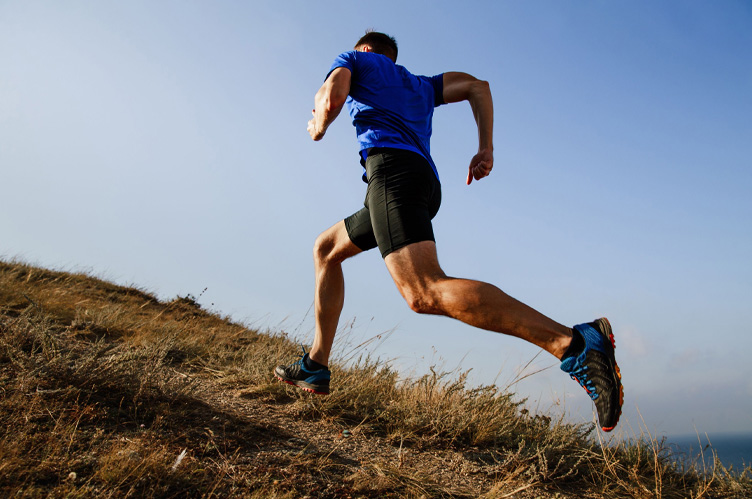
 ШӯШұЪ©ШӘ ШҜШіШӘ
ШӯШұЪ©ШӘ ШҜШіШӘ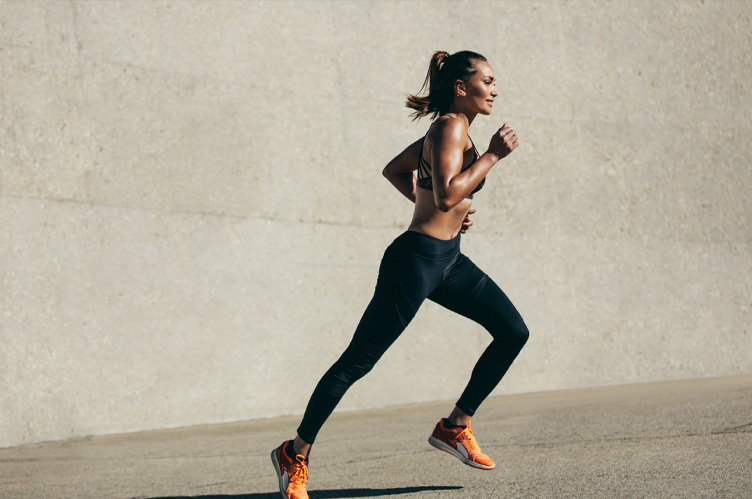 ЩҮЩҶЪҜШ§ЩҶ ШҜЩҲЫҢШҜЩҶ ШұЩҲЫҢ ШЁШ§ШіЩҶ Ш®ЩҲШҜ ШӘЩ…ШұЪ©ШІ Ъ©ЩҶЫҢШҜ
ЩҮЩҶЪҜШ§ЩҶ ШҜЩҲЫҢШҜЩҶ ШұЩҲЫҢ ШЁШ§ШіЩҶ Ш®ЩҲШҜ ШӘЩ…ШұЪ©ШІ Ъ©ЩҶЫҢШҜ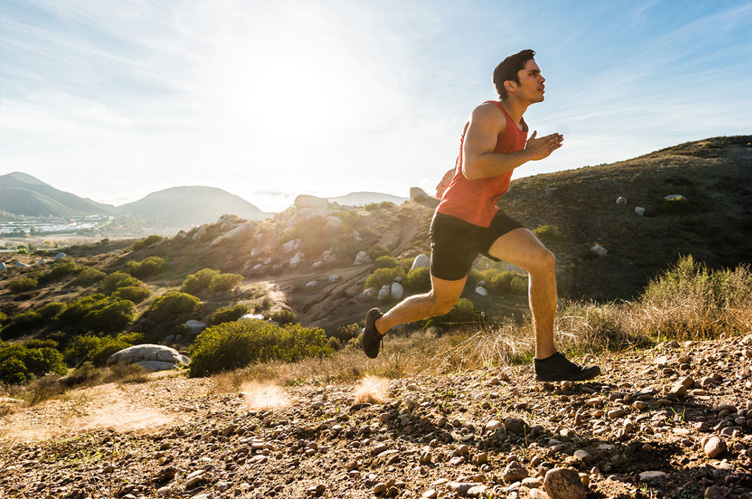 Ш§ЩҲШ§ЫҢЩ„ ШЁШұЩҶШ§Щ…ЩҮ
Ш§ЩҲШ§ЫҢЩ„ ШЁШұЩҶШ§Щ…ЩҮ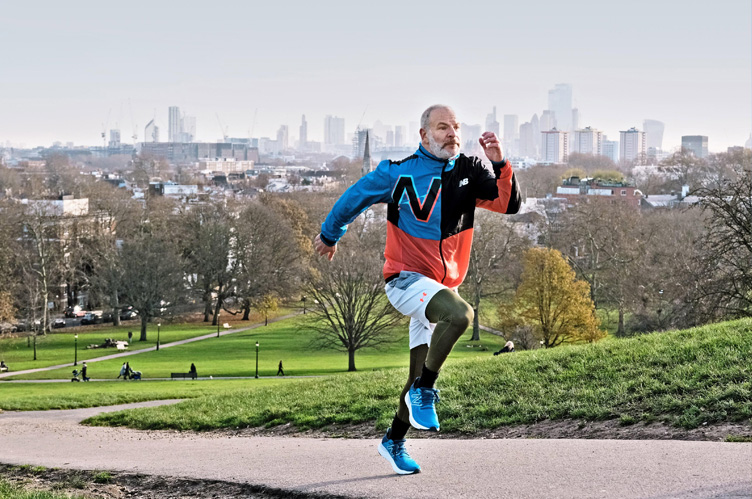 ЩҮЫҢЩ„ Ш§ШіЩҫШұЫҢЩҶЪҜ
ЩҮЫҢЩ„ Ш§ШіЩҫШұЫҢЩҶЪҜ


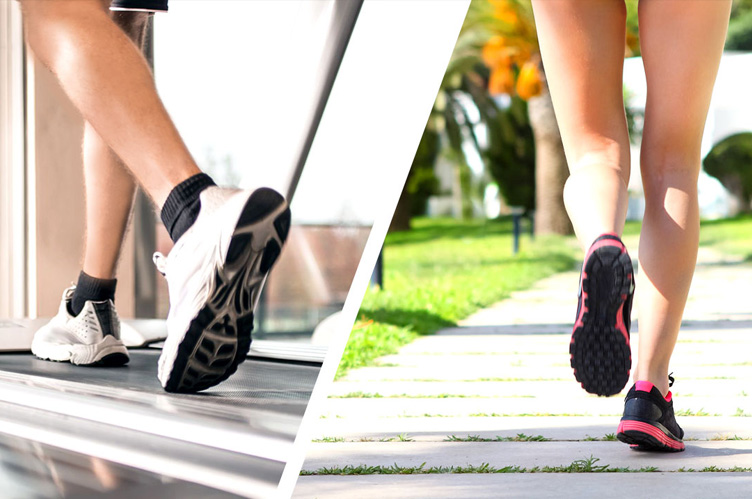 The debate over running on a treadmill vs. outside is not a new one. Running outdoors can improve stability by forcing you to navigate ever-changing terrain. But a treadmill forces you to sustain speed and performance levels that might otherwise lag outdoors.
Ultimately, there is no right or wrong answer to the debate over treadmill vs. outside running. Both methods have their pros and cons based on your individual training needs and goals and both can have their place in your running routine.
The debate over running on a treadmill vs. outside is not a new one. Running outdoors can improve stability by forcing you to navigate ever-changing terrain. But a treadmill forces you to sustain speed and performance levels that might otherwise lag outdoors.
Ultimately, there is no right or wrong answer to the debate over treadmill vs. outside running. Both methods have their pros and cons based on your individual training needs and goals and both can have their place in your running routine.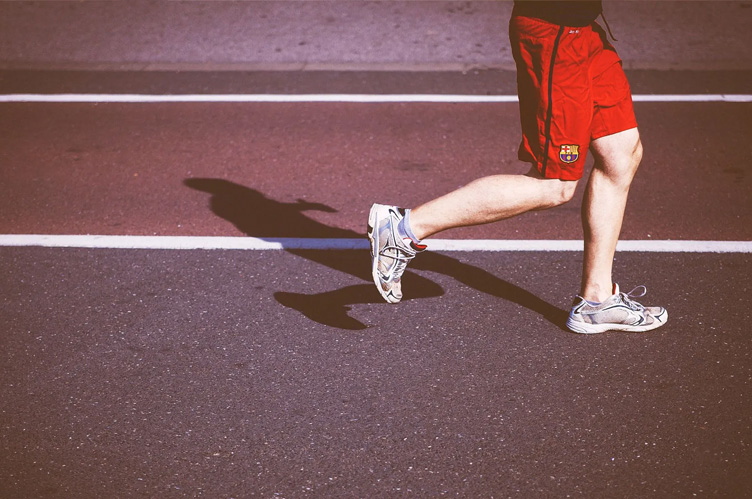
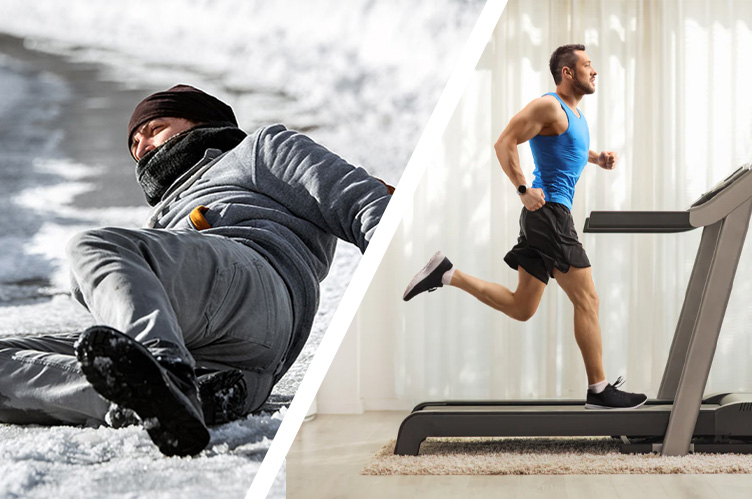
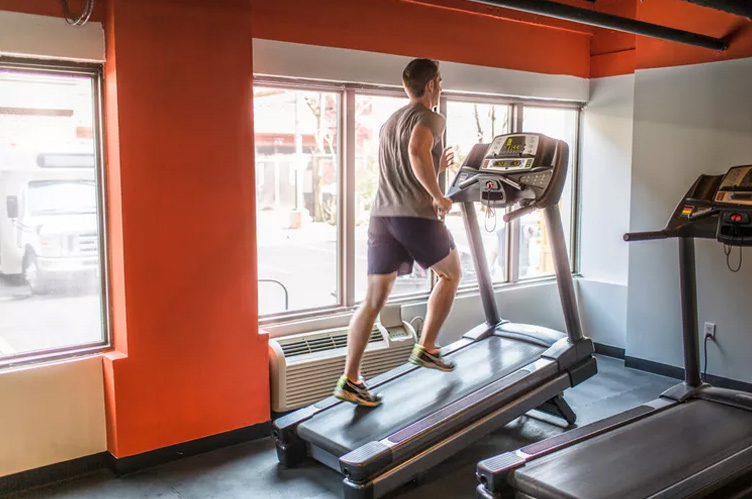 You can even use treadmill runs to try out race day clothing and make sure your gear will work for you.
You can even use treadmill runs to try out race day clothing and make sure your gear will work for you.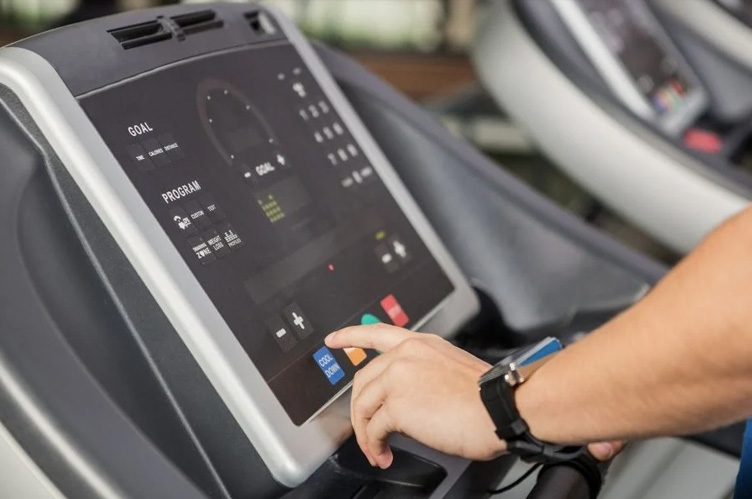 You can also stop anytime you want. But you can also use the treadmill pace to push yourself.
You can also stop anytime you want. But you can also use the treadmill pace to push yourself.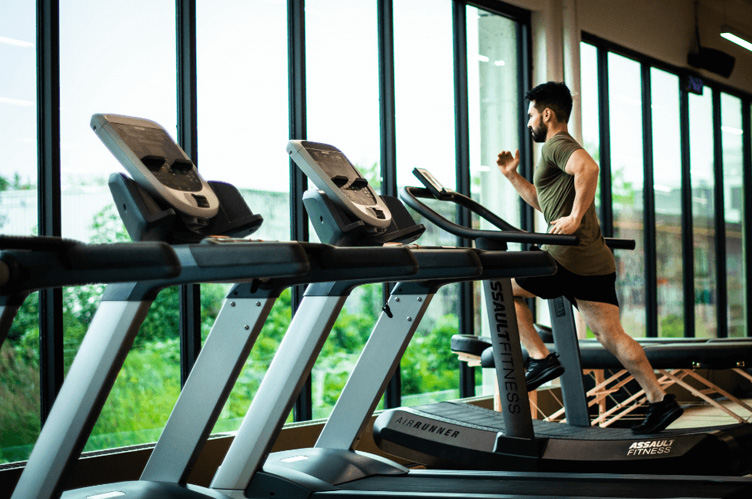 Treadmills offer better shock absorption than pavement or roads, which means less stress on the ankles and knees. And when you run at an incline on the treadmill, you build strength and endurance like you would running hills outside. But you don't have to run downhill, which can be hard on your body.
Treadmills offer better shock absorption than pavement or roads, which means less stress on the ankles and knees. And when you run at an incline on the treadmill, you build strength and endurance like you would running hills outside. But you don't have to run downhill, which can be hard on your body.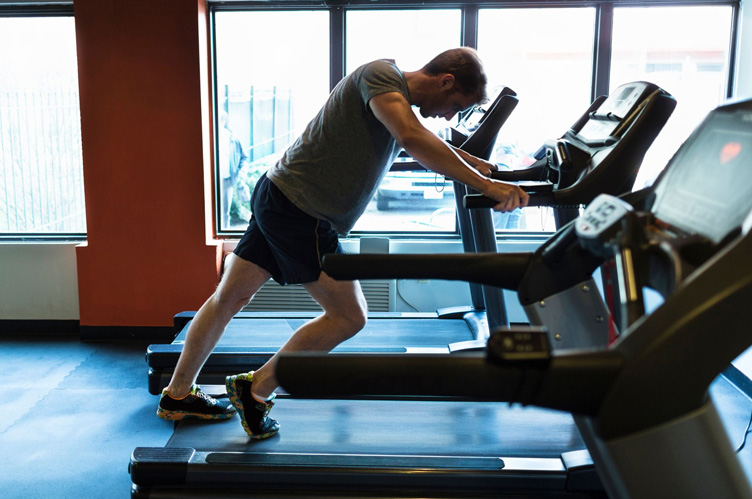 While treadmills are considered the safer option by most users, the CPSC reports that there are more than 24,000 treadmill-related injuries in the U.S. each year. These include sprains, falls, head injuries,2 and cardiovascular events in people who either ran too fast or pushed too hard. (But the figures for outdoor runners are much higher.)
While treadmills are considered the safer option by most users, the CPSC reports that there are more than 24,000 treadmill-related injuries in the U.S. each year. These include sprains, falls, head injuries,2 and cardiovascular events in people who either ran too fast or pushed too hard. (But the figures for outdoor runners are much higher.)
 It Provides Sport-Specific Training for Road Races
It Provides Sport-Specific Training for Road Races It Can Be Motivating
It Can Be Motivating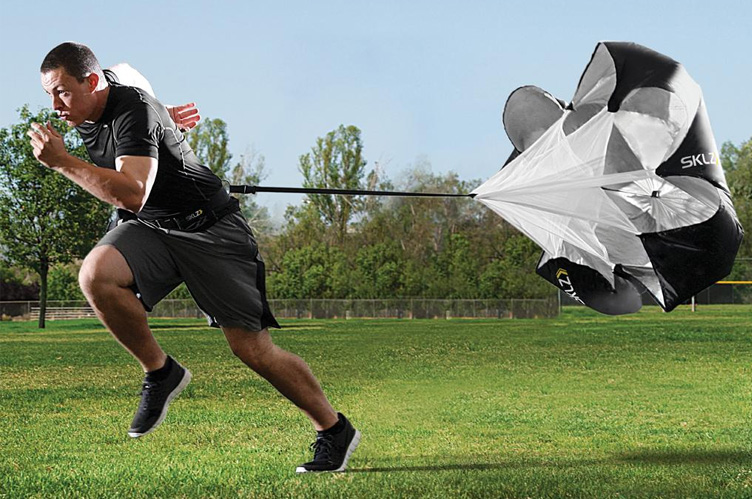 Cons
Cons Additionally, running outside means you're watching the heat and humidity index to avoid potential heat exhaustion in the hot summer months.
Additionally, running outside means you're watching the heat and humidity index to avoid potential heat exhaustion in the hot summer months. On the other hand, when training for a race event, you will clearly benefit more from running outside. While you can incorporate treadmill running to improve your cardio health, experts generally recommend limiting it to no more than 40% of your overall training.
On the other hand, when training for a race event, you will clearly benefit more from running outside. While you can incorporate treadmill running to improve your cardio health, experts generally recommend limiting it to no more than 40% of your overall training.
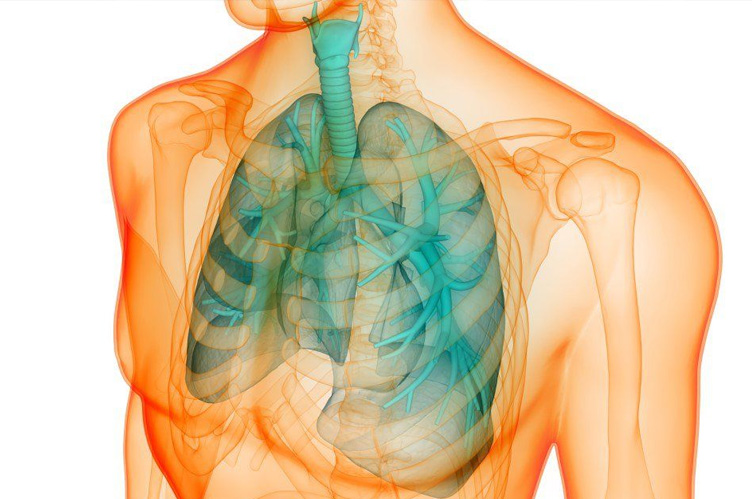 Our lungs are pretty important when we are running, not to mention just for day to day life, so taking good care of them is a top priority.
Our lungs are pretty important when we are running, not to mention just for day to day life, so taking good care of them is a top priority.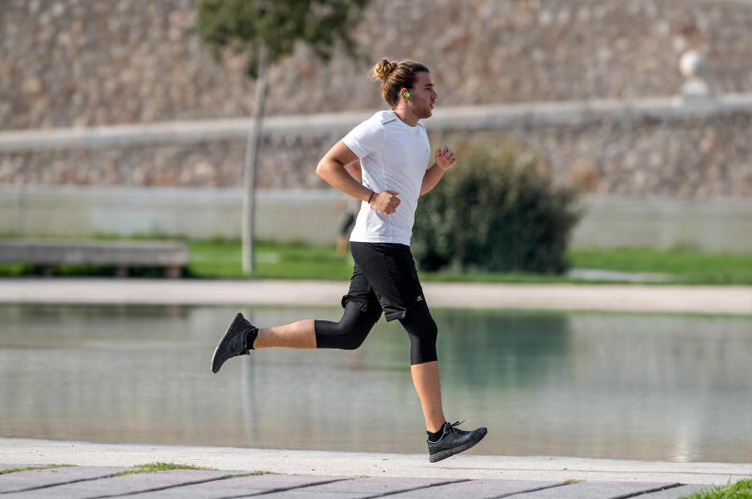
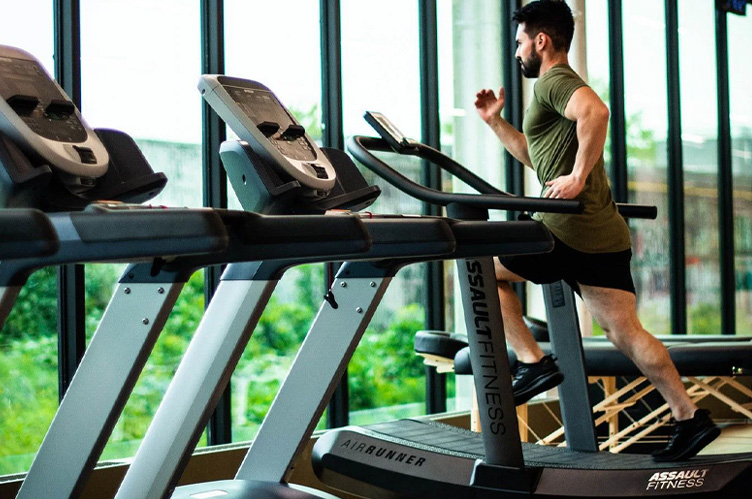 Number 2, in cold air, emissions tend to get trapped at ground level in a process known as temperate inversion. Hotter air sits above the colder air at ground level and acts like a cap keeping the cold air from dissipating.
Number 2, in cold air, emissions tend to get trapped at ground level in a process known as temperate inversion. Hotter air sits above the colder air at ground level and acts like a cap keeping the cold air from dissipating.
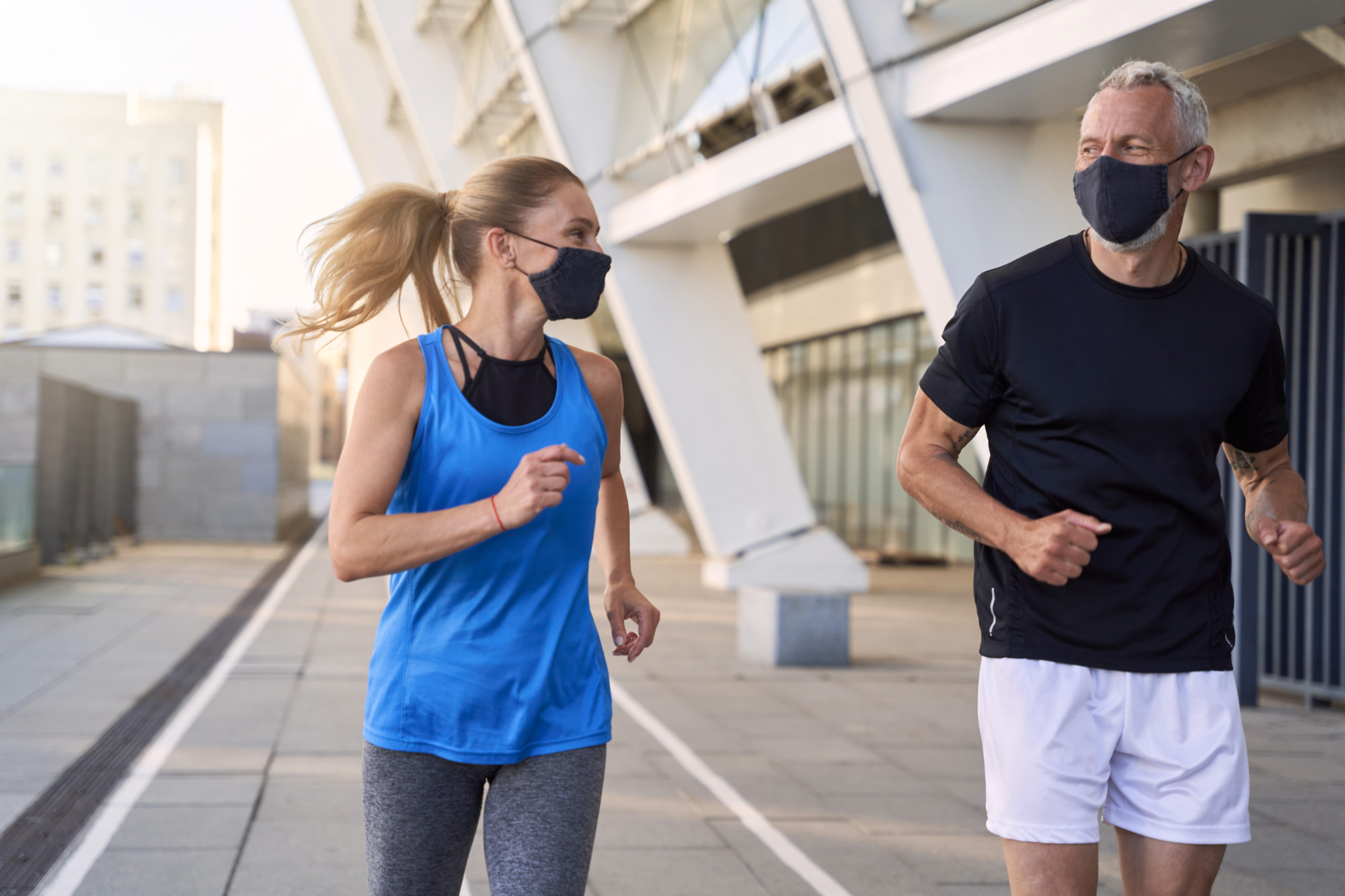


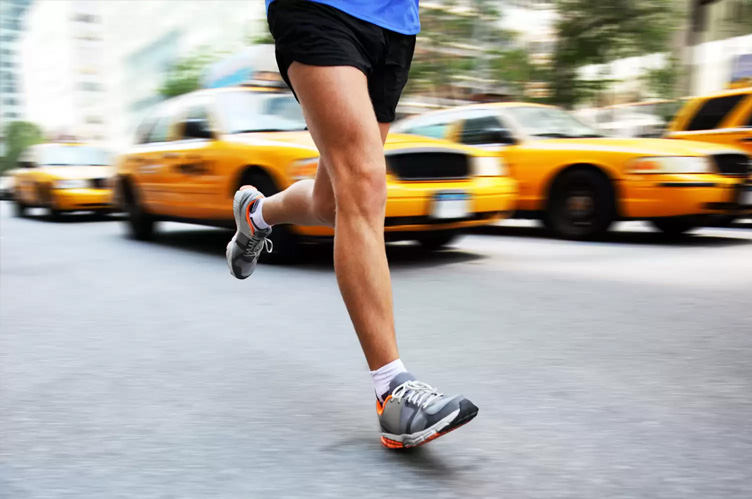 So when you head out avoid running down busy roads if you can and avoid peak traffic times to avoid running in poor air quality.
So when you head out avoid running down busy roads if you can and avoid peak traffic times to avoid running in poor air quality.